
| JAPANESE | TOP PAGE | |
|---|---|---|
| 0 | 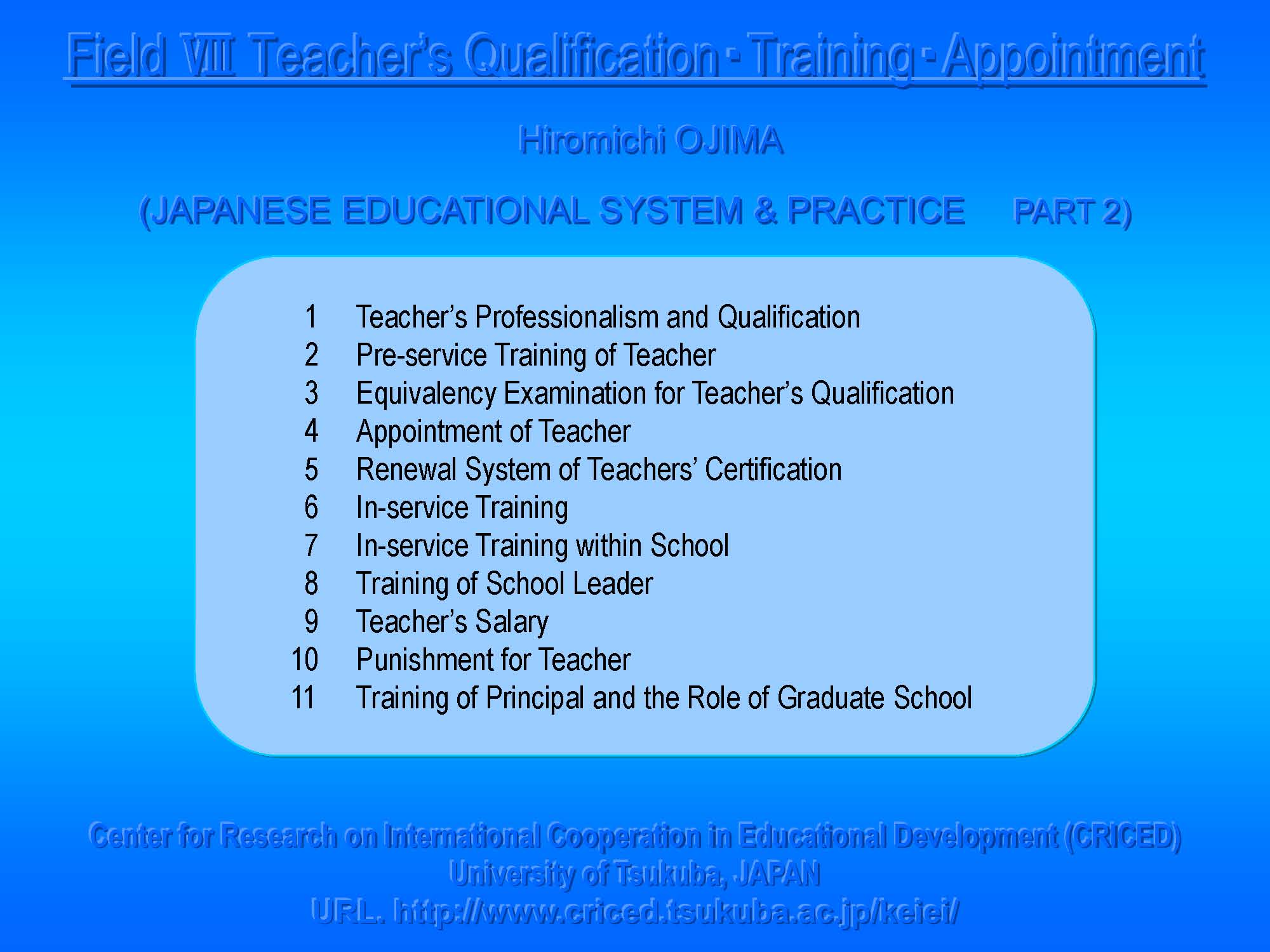 |
Download : VIII Teacher's Qualifications / Training / Appointment |
| 1 | 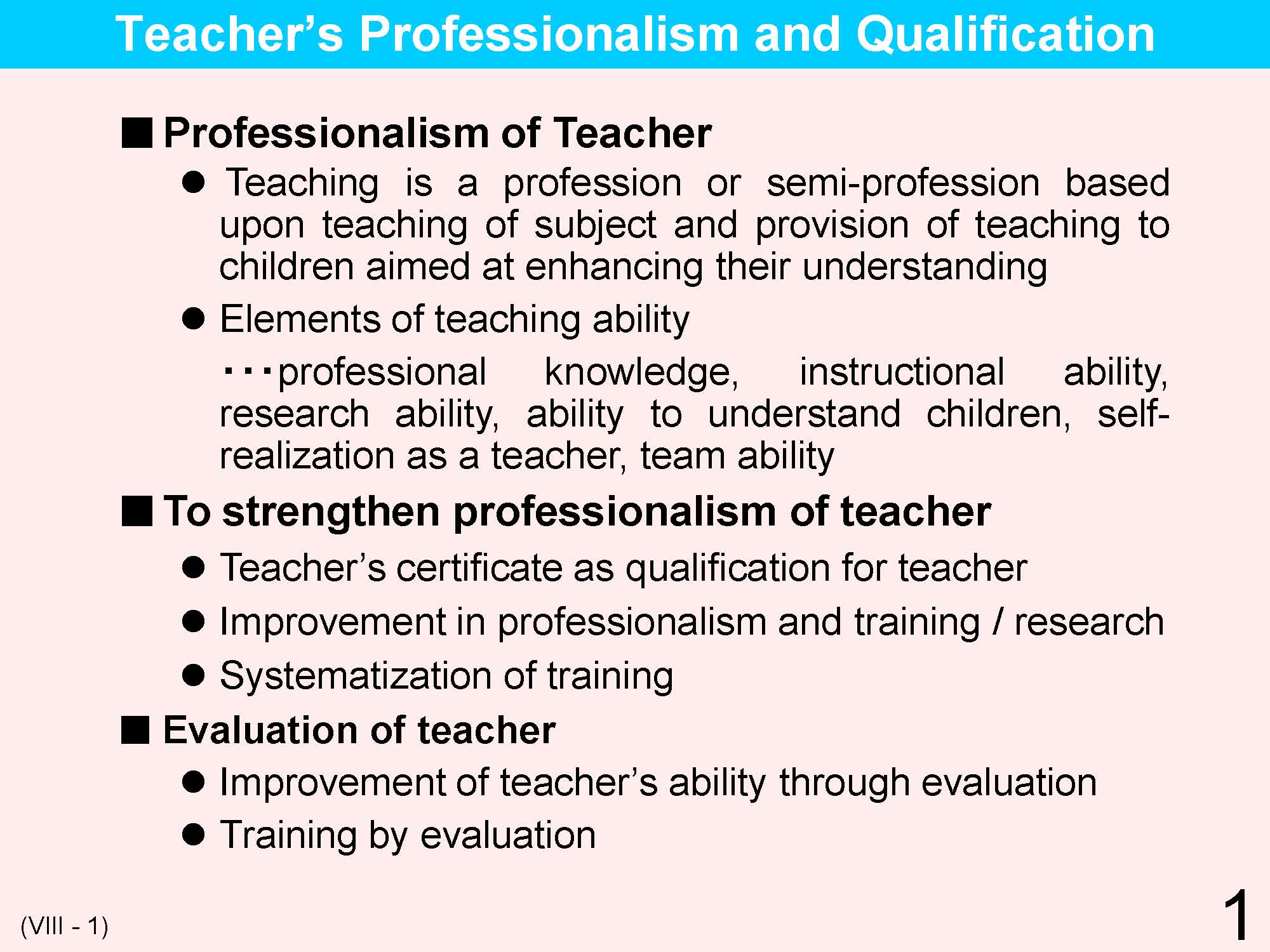 |
Teachers teach children using educational contents that are based on educational values derived from science, art and culture that have been created and compiled through human life experiences, and that are based on the developmental level of children. Children select future jobs by learning from and mastering these educational contents and then utilizing the associated skills to help direct their own lives. The professionalism of teachers depends upon a deep understanding of both educational contents and children, including the ability to use and develop educational activities though teaching. Japan prefers diversity rather than uniformity in teachers, considering the fact that teachers need to have a practical capacity for providing guidance, an appropriate personality as well as specialty skills as seen from an international point of view. At the present, inadequate capacities of teachers to provide appropriate guidance has emerged as a problem, and that has forced a change in the concept of the status and skill requirements of teachers. Also, policies are being adopted to increase teaching guidance skills by reformulating and clarifying the system of evaluating teachers, such as through personnel reports. An emerging educational feature of Japan is demonstrated by its promotion of the concept that teachers guidance and teaching skills should also be reflected in their own professional development as teachers. In order to improve professionalism, training of teachers is conducted at universities. Teachers require certificates to become teachers meeting national standards. There is also an accompanying training system to maintain and improve professionalism. There are various policies to improve professionalism. Among others these include introducing teachers' evaluations through personnel reports, and improving teachers' professional capacity through the introduction of training programs for teachers who have accumulated 10 years of teaching experience. |
| 2 | 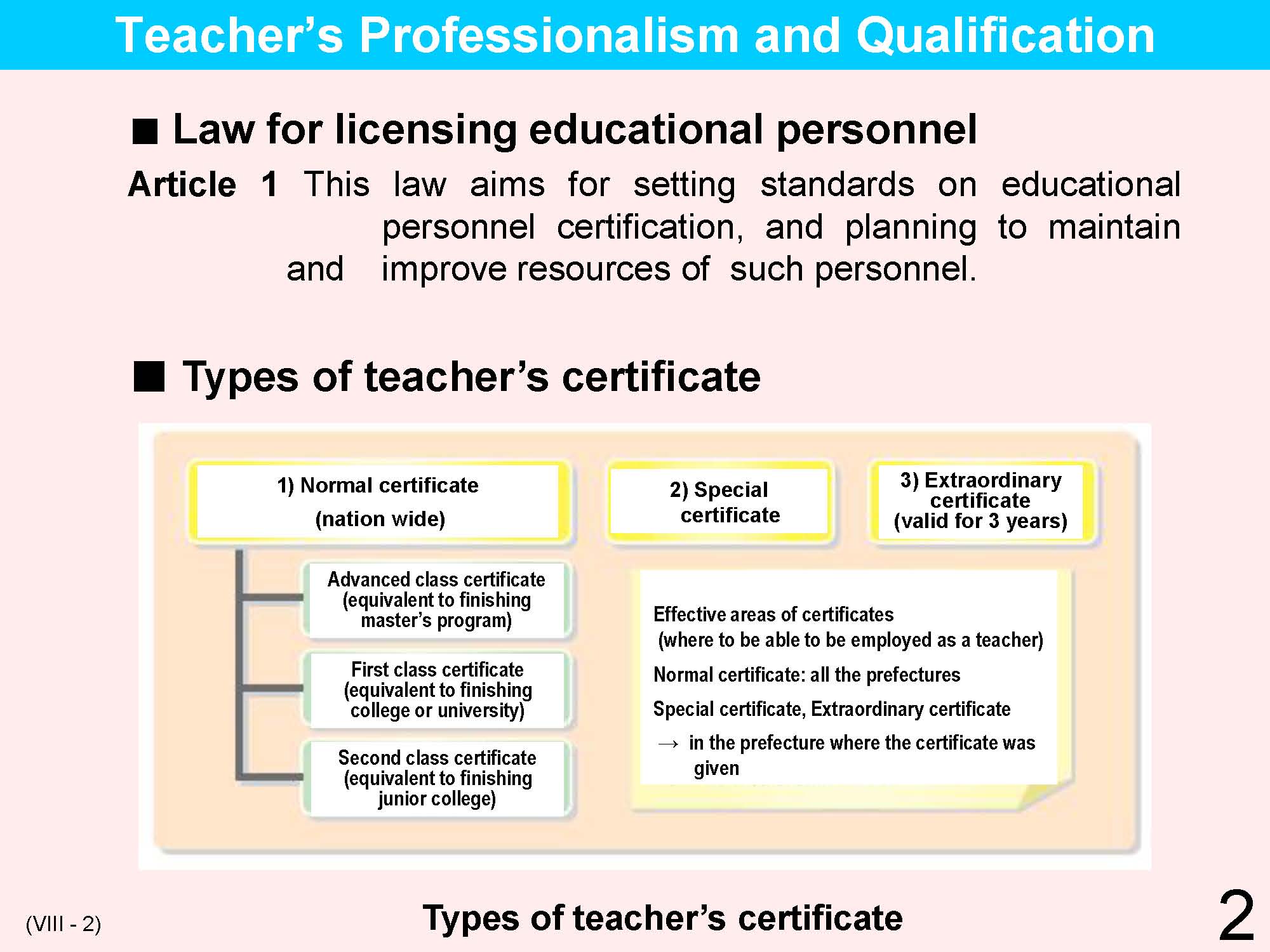 |
For teachers' certificates, there are normal certificates, special certificates and extraordinary certificates. Normal certificates include various types of specialized certificates (basic qualification: master's degree), 1st-type certificates (basic qualification: bachelor's degree), and 2nd-type certificates (basic qualification: associate's degree). Extraordinary certificates are valid for 3 years. The special certificate system is a system to provide special certificates to civilians who do not have teachers‘ certificates but who wish to teach and have superb knowledge, experience and technical skills in certain fields. It requires a special education personnel examination that is conducted by the prefectural boards of education that appoint such people as teachers. This system was introduced in 1988 with the revision of the law for licensing educational personnel. Extraordinary certificates are given to persons who pass the educational personnel examination only in situations when persons with teachers' certificates are not available to be appointed. Among the teachers’ certificates, normal certificates are awarded most often, which means most teachers have normal certificates. http://www.mext.go.jp/a_menu/shotou/miryoku/_icsFiles/afieldfile/2009/09/03/1283833.pdf |
| 3 | 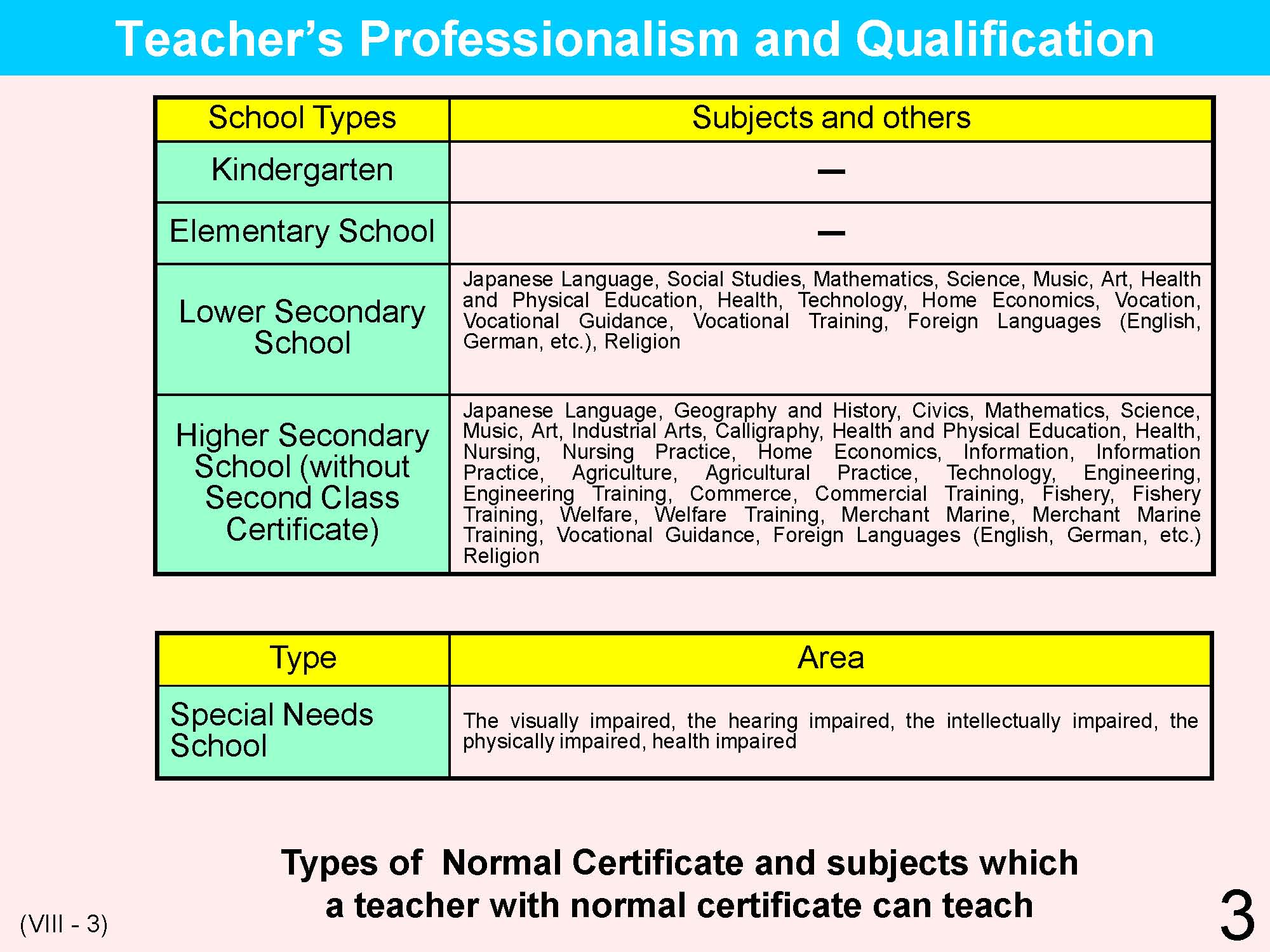 |
Normal certificates differ according to types of schools. Certificates for elementary school teachers are for all the subjects because elementary school teachers teach all the subjects. For lower and higher secondary school teachers, different certificates are given for different subjects. |
| 4 | 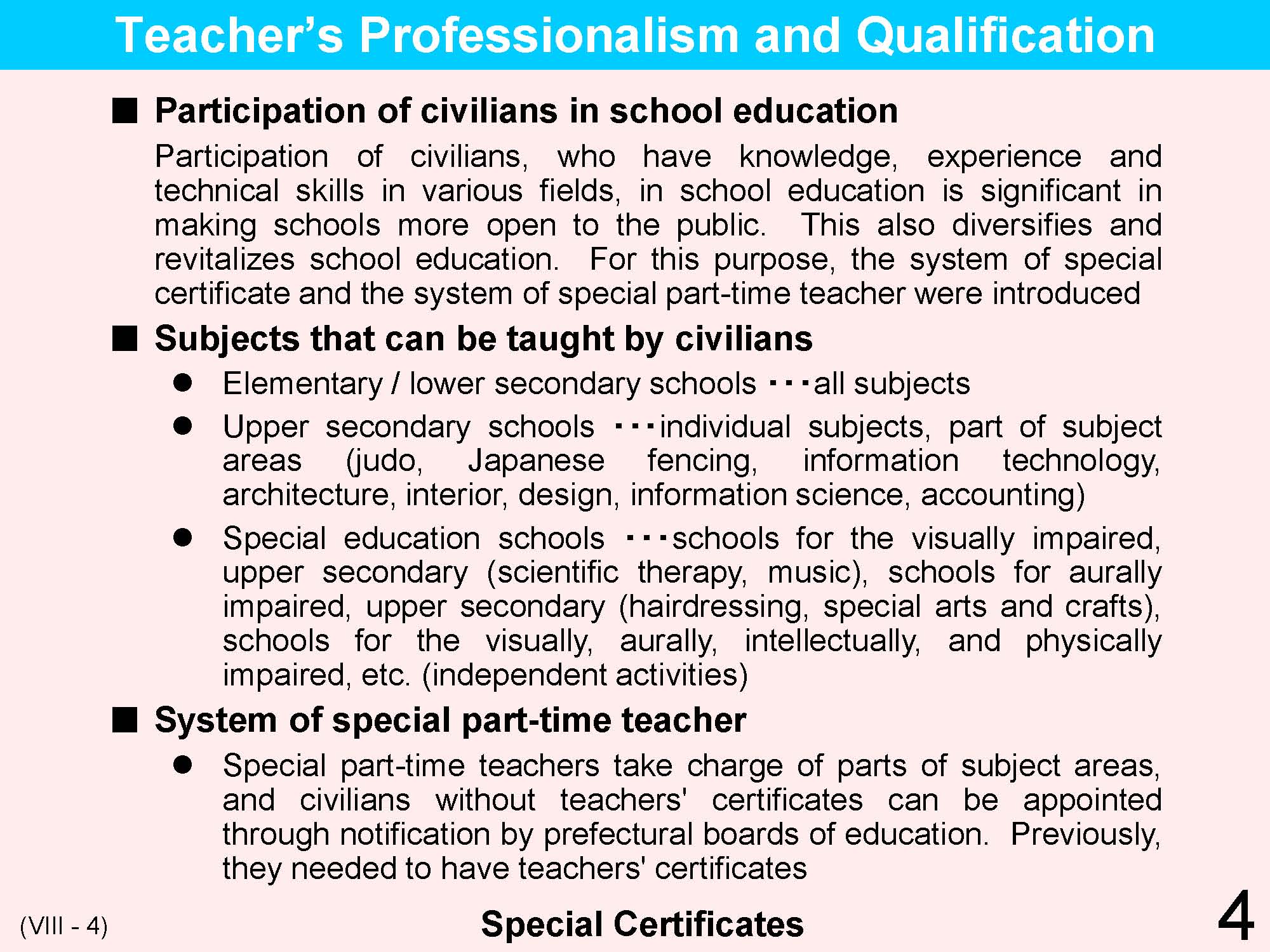 |
Following is an explanation regarding the status of special part-time teachers. Subjects which special part-time teachers can teach are the following: Elementary schools: parts of all subjects, club activities Lower and upper secondary schools: portions of individual subjects, parts of the period of integrated study and moral education Schools of special education: part of individual subjects, club activities (elementary schools), parts of the period of integrated study and moral education. There are 20,392 special part-time teachers in 2003; 8,249 at elementary schools, 3,324 at lower secondary schools, and 8,589 at upper secondary schools. The regular jobs of the special part-time teachers are as follows. Elementary schools: instructors of Japanese drums, carpenters at sawmills, instructor of courses at cultural centers. Lower secondary schools: OA instructors, sports instructors, instructors of tea ceremonies / flower arrangements, Noh instructors. Upper secondary schools: NPO staff, staff of welfare facilities, nurses, chief chefs at hotels. Schools of special education: doctors, pharmacists, scientific therapists |
| 5 | 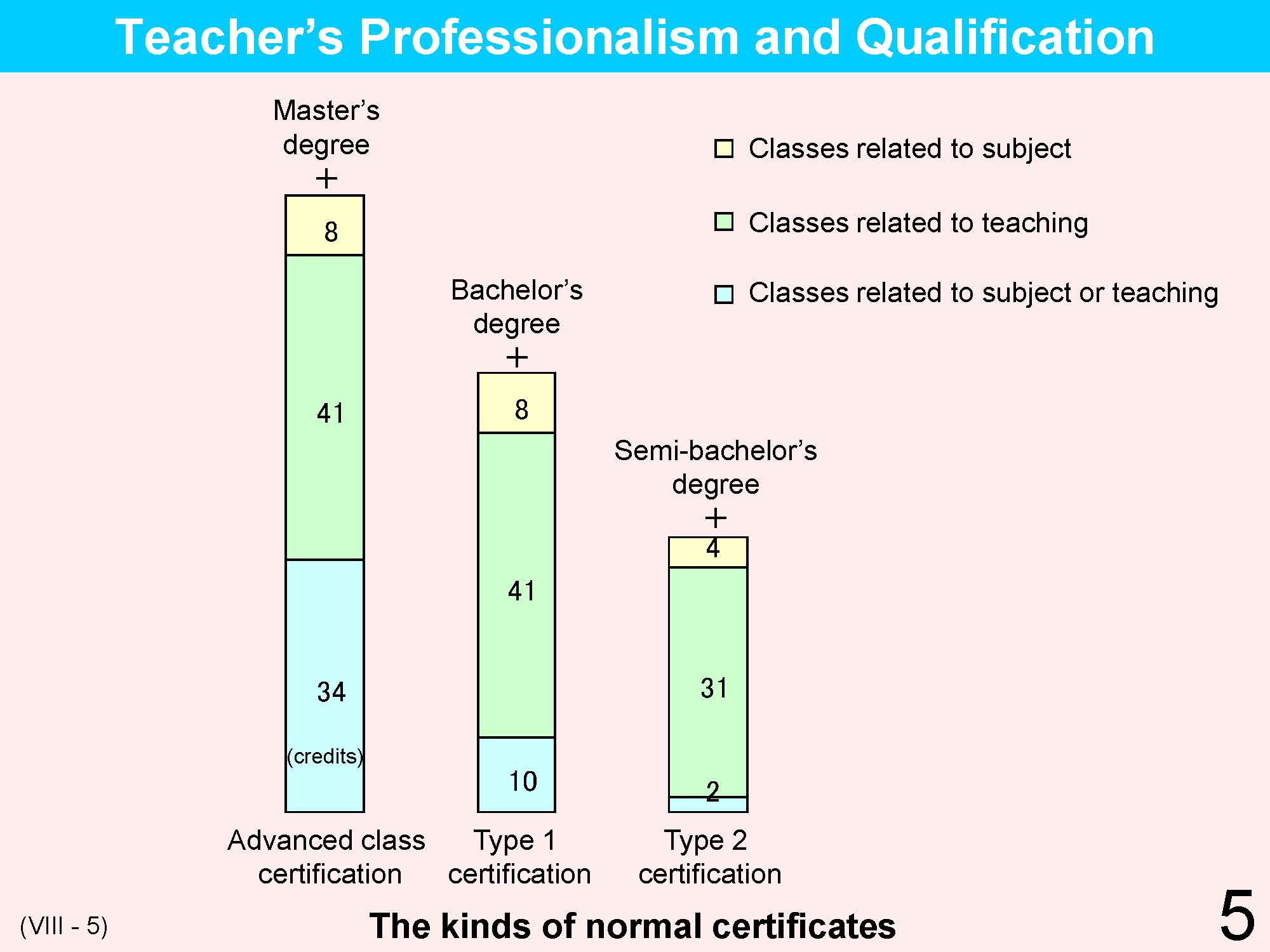 |
There are 3 types of teachers’ certificates: advanced class certification that is given to those who have completed master's degrees and taken advanced instruction, type 1 certification that is given to those who have completed necessary units at 4-year universities (bachelor's degrees), and type 2 certification that is given to those who have completed necessary units at junior colleges (associates' degree) In order to obtain the advanced class certification, it is necessary to complete 34 units of classes on specialized subjects, 41 units of classes on teaching, and 8 units of classes on specialized subjects or teaching. For the type 1 certification, the numbers of units are 10 units, 41 units, and 8 units, and for the type 2 certification, they are 2 units, 31 units, and 4 units, respectively. |
| 6 | 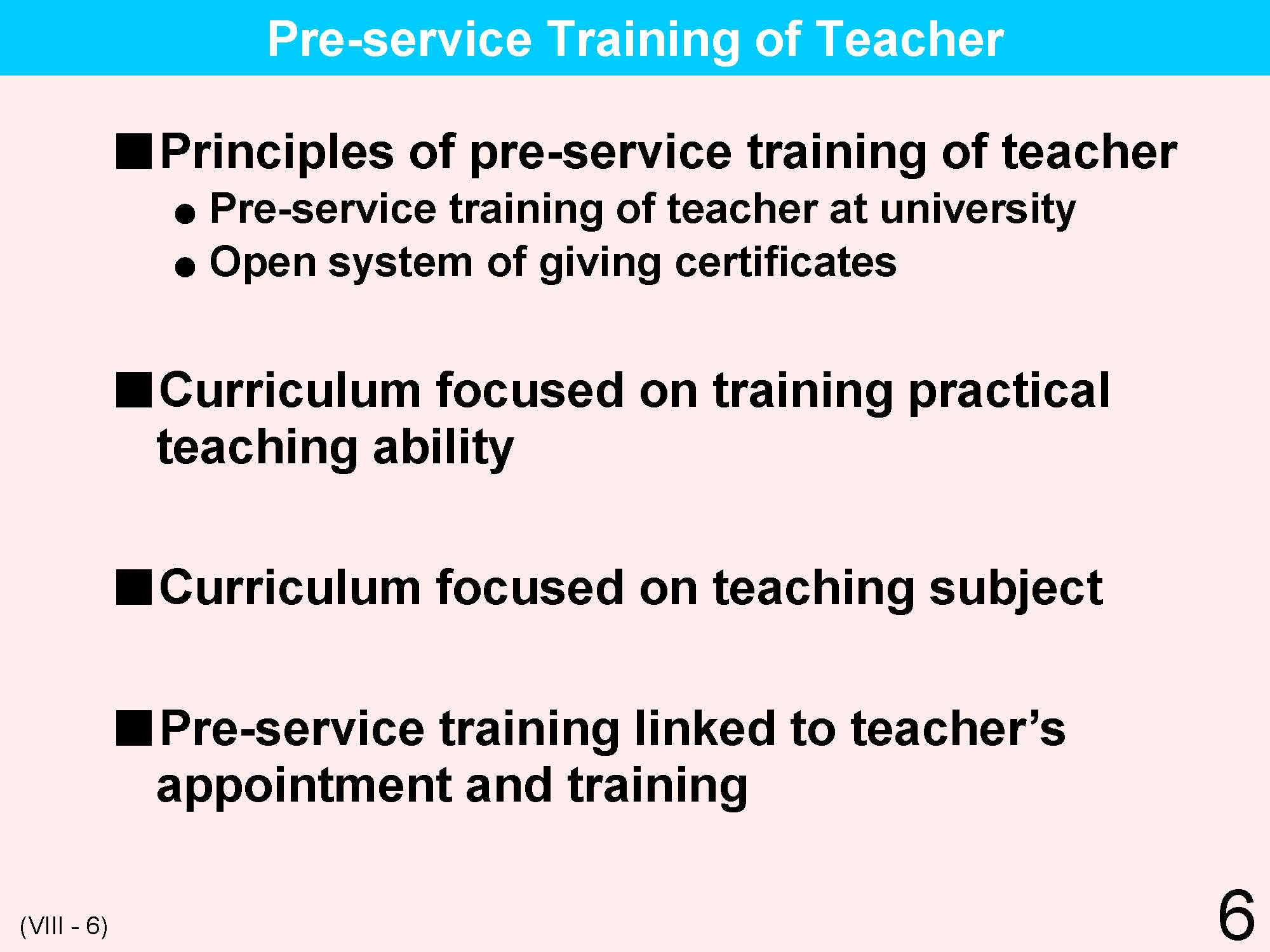 |
Before WW2, the teacher’s schools conducted pre-service training for elementary school teachers. The teacher’s schools were secondary schools, that is to say, educational institutions which were cut off from academics. On the other hand, teachers of secondary schools were mostly graduates from higher educational institutions such as colleges or universities, though they hadn’t received training to be a teacher. After WW2, institutional reform was conducted, under the ground that all the teachers of elementary and secondary schools be trained at colleges or universities where academic freedom is guaranteed. In order to be an open system, universities are permitted to have courses of pre-service training of teachers approved by the minister of education, culture, sports, science and technology, even if the primary goals of the universities are not directed at teacher's training. This change was made because it came to be recognized that teaching required a high level of professionalism and that university education would be suitable for achieving this purpose. Nowadays, pre-service teacher training is conducted using curriculums focused on building the basics of practical teaching abilities. The practical ability to teach is not only the ability to impart knowledge, but also involves the ability to guide and teach children through the ability to understand, communicate and relate to children through teaching and regular guidance. The pre-service training of teachers also focuses on teaching classes designed to nurture practical teaching abilities. Pre-service teacher training is considered to be a part of the normal teacher's training process, designed to link up the appointment of current teachers with training. |
| 7 | 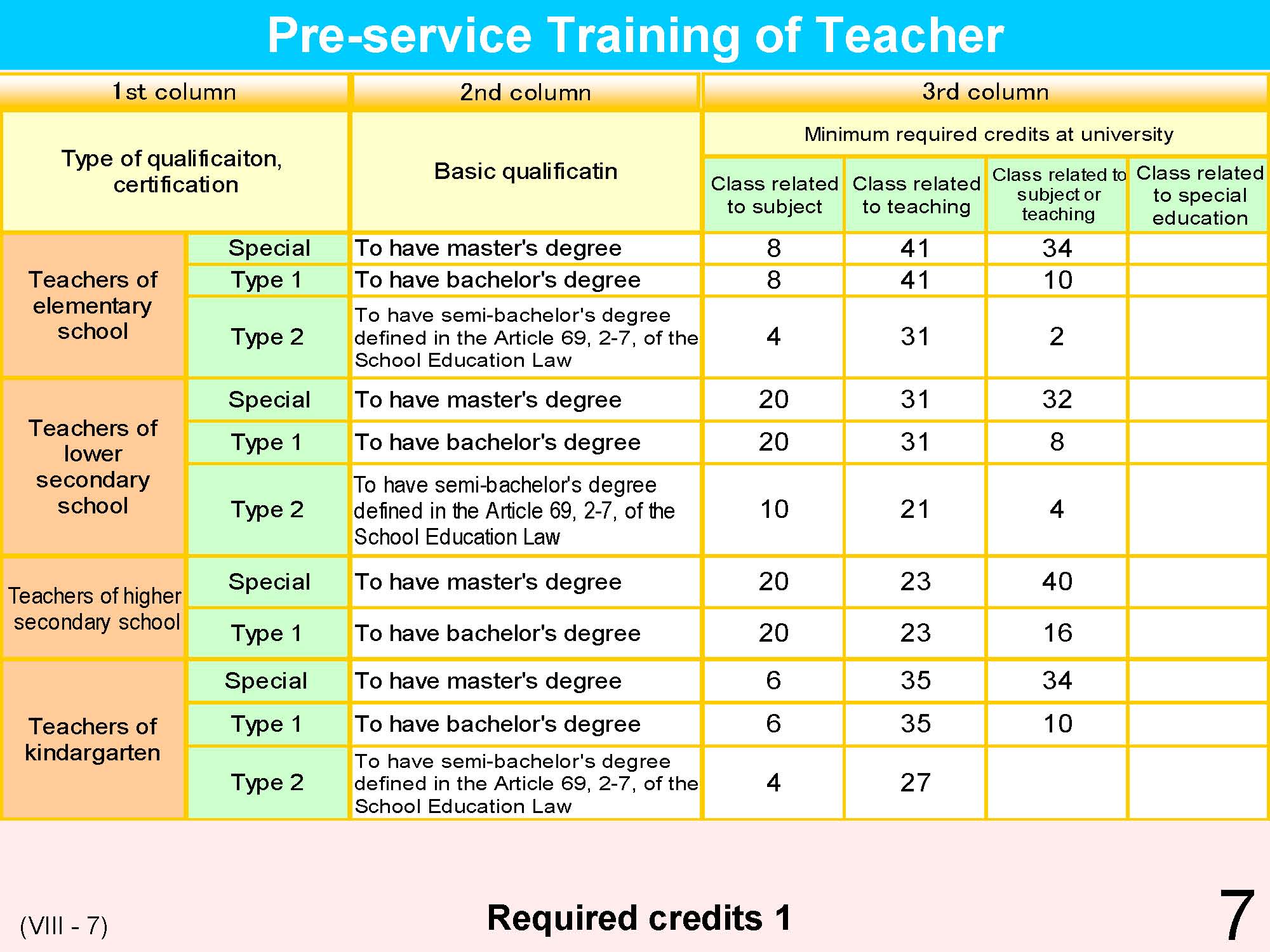 |
In terms of courses, pre-service teacher training in Japan occurs at 461 universities, 398 colleges, 214 graduate schools, and involves 69 majors at accredited universities.(as of 1998) The course subjects required to receive conferment of a license comprise specialized subjects at individual universities comprise: ●Curriculums about a subject ●Curriculums about the teaching profession ●Curriculums regarding the teaching profession are mainly as follows: -Curriculums concerning the meaning of the teaching profession -Curriculums concerning basic educational theories -Curriculums concerning school curriculums and instruction methods -Curriculums concerning student guidance, educational consultation, carrier guidance, etc. -Seminars -Teaching practice ●Curriculums concerning subjects or the teaching profession ●Curriculums concerning special education ●Curriculums concerning protective care ●Curriculums concerning protective care or the teaching profession ●Curriculums concerning nutritional education |
| 8 | 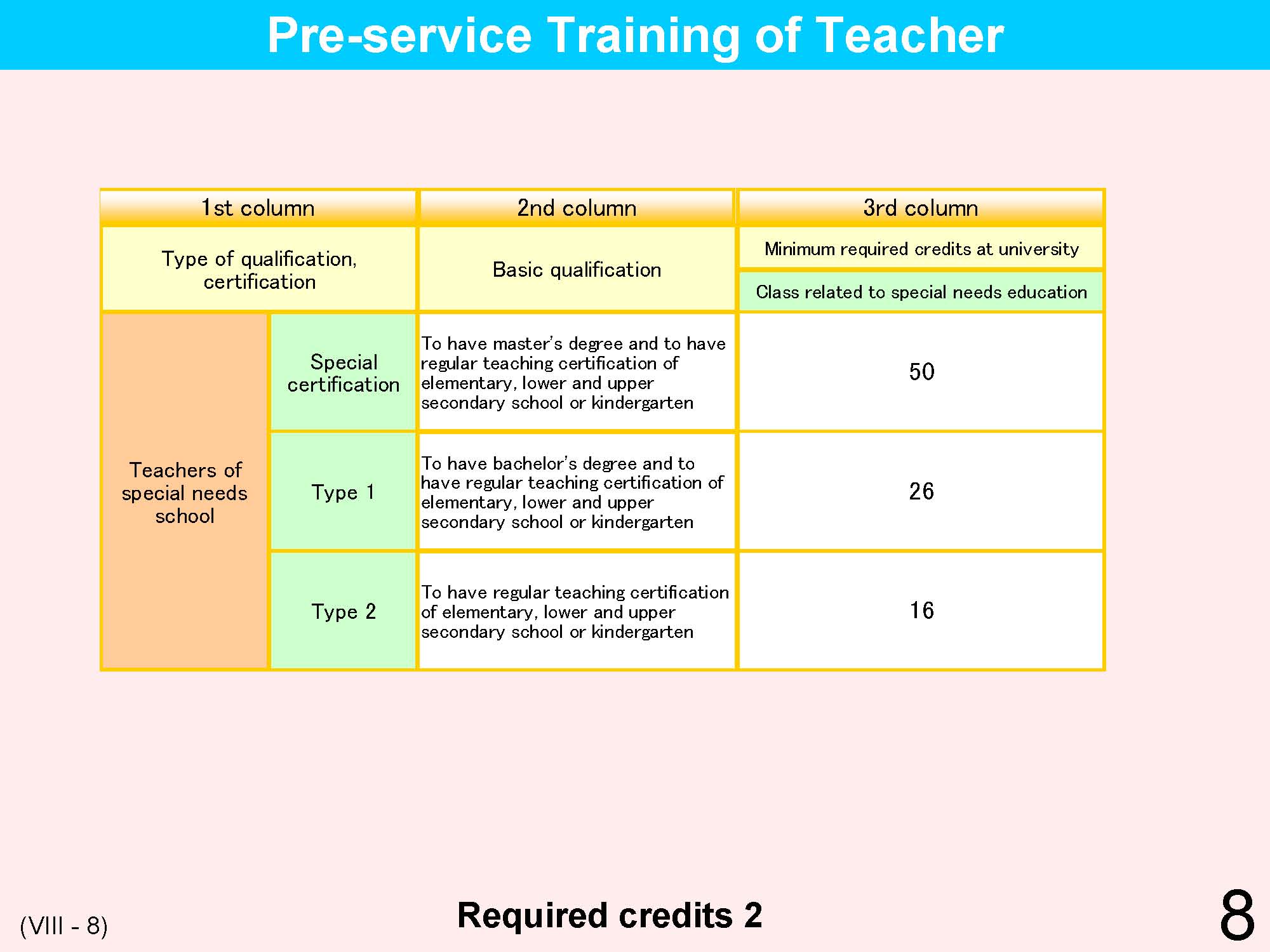 |
There had been different certificate for teachers of schools for the visually-impaired, those of schools for the aurally challenged, and those of schools for the physically or mentally challenged, which were integrated in 2007. Certificate is now given specifying type of disabilities for which the teacher can teach. |
| 9 | 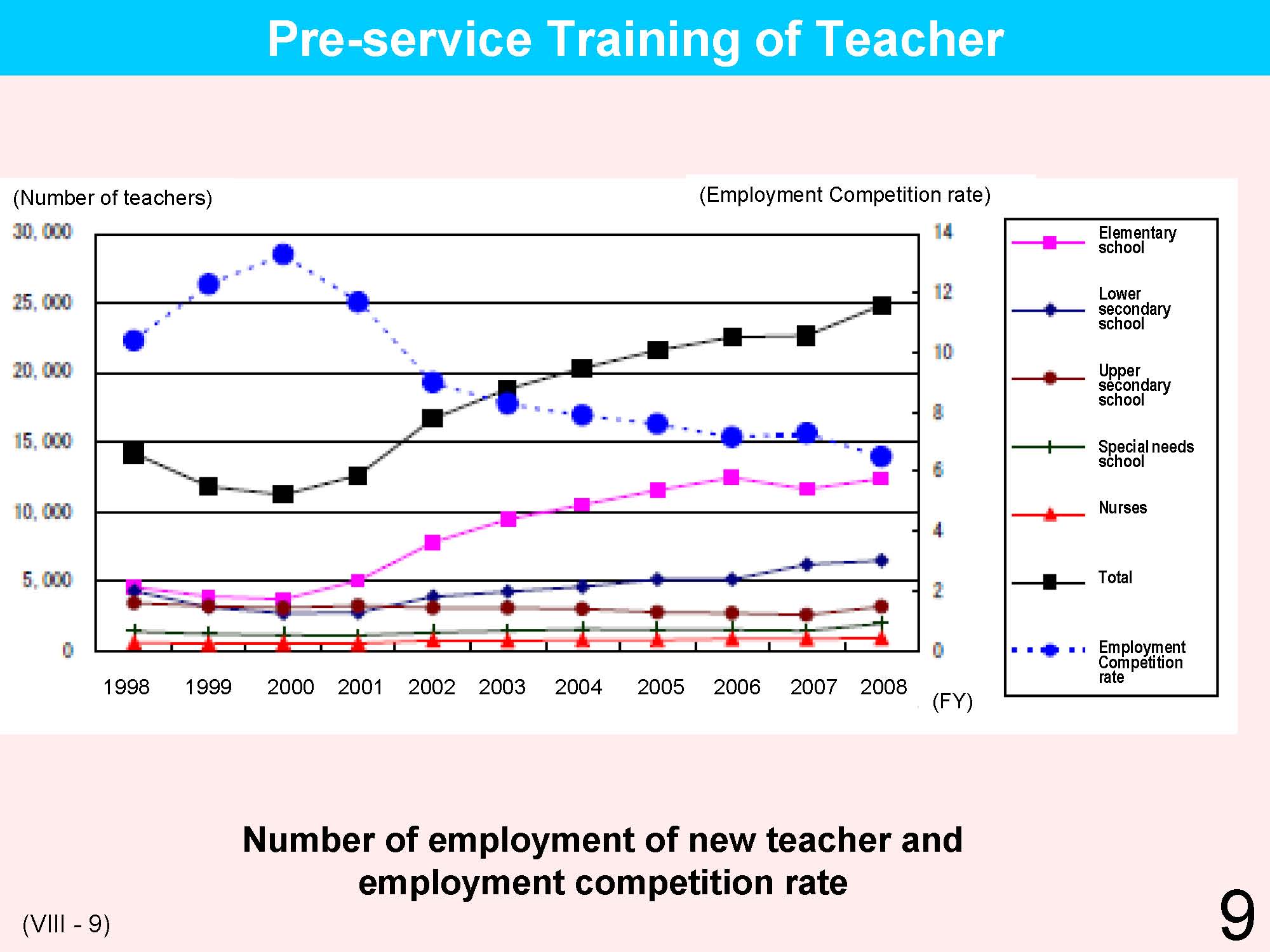 |
The level of employment of new teachers has fluctuated drastically over the time due to the changes in the number of pupils and students, and the age composition of currently in-service teachers. The trend of the past 10 years shows employment demand for new teachers has been increasing because of an increase in teachers retiring from public schools, which has resulted in the increase of employment of new teachers, especially in elementary schools. |
| 10 | 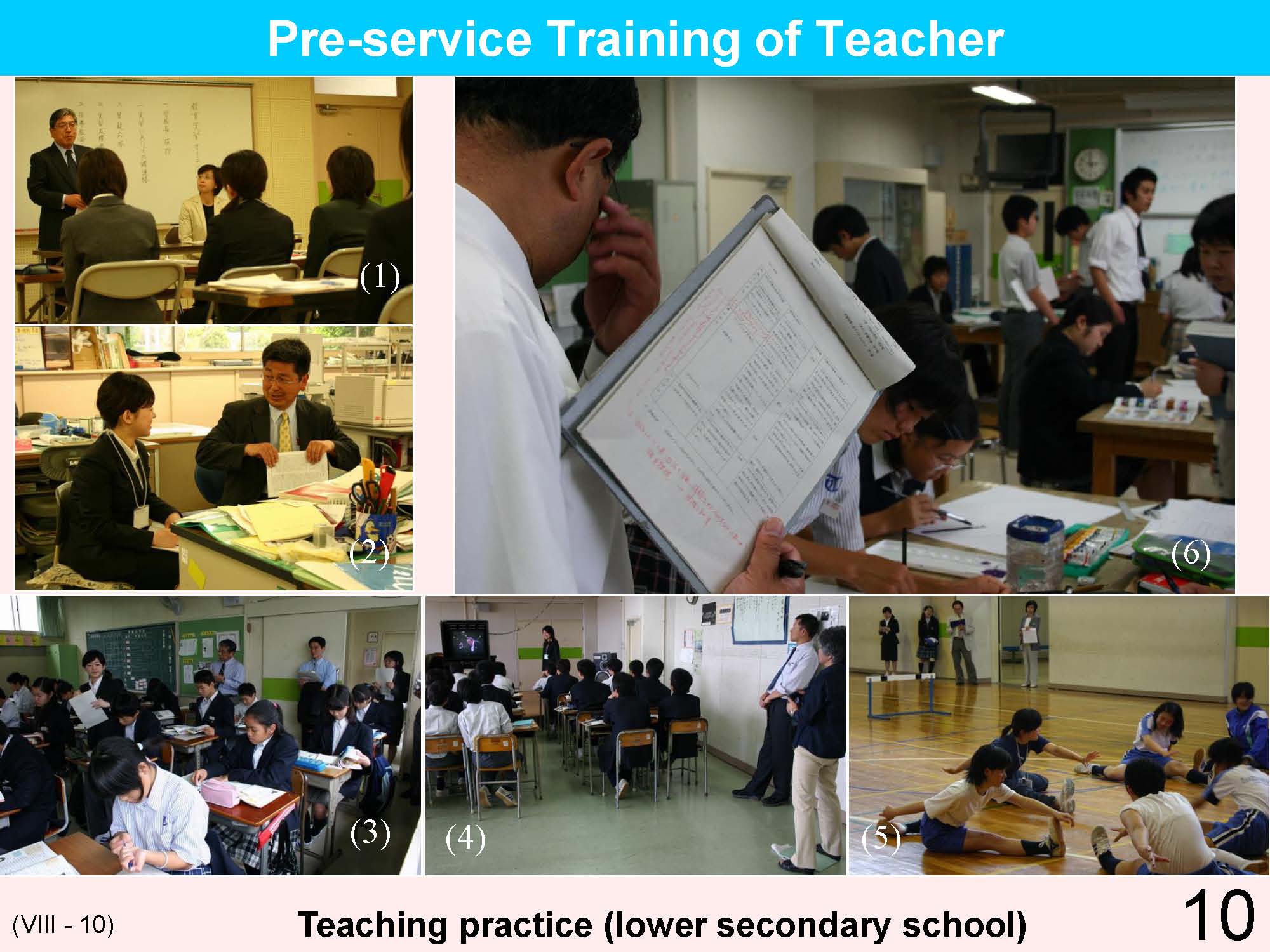 |
In pre-service training of teachers, training practice is an important component designed to develop basic and practical teaching skills. Practical teacher training has been improved by the extension of the training requirements. Currently, 5 units of practical training are required for elementary schools, 5 units for lower secondary schools, 3 units for upper secondary schools and 5 units for schools for special education. Also, in 1998, it became obligatory to undergo an “experience of caring” ( 7 days) to obtain a normal teachers' certification for elementary and lower secondary schools. The aim of this special experience aim “to improve the quality of teachers working for schools of compulsory education, and to better fulfil compulsory education, considering the importance of deepening the understanding of teachers regarding the dignity of individuals as well as of social solidarity.” (Law on special cases of the law on licensing educational staff, relating to the normal certification of teachers for elementary and lower secondary schools) (1) Orientation (principle’s speech), May 2005 (2) Meeting with a home-room teacher, May 2005 (3) Class visit (social studies, 1st grade), June 2005 (4) Class visit (music, 2nd grade), June 2005 (5) Class visit (physical education, 1st grade), June 2005 (6) Class visit (drawing and handcraft, 2nd grade, June 2005 |
| 11 | 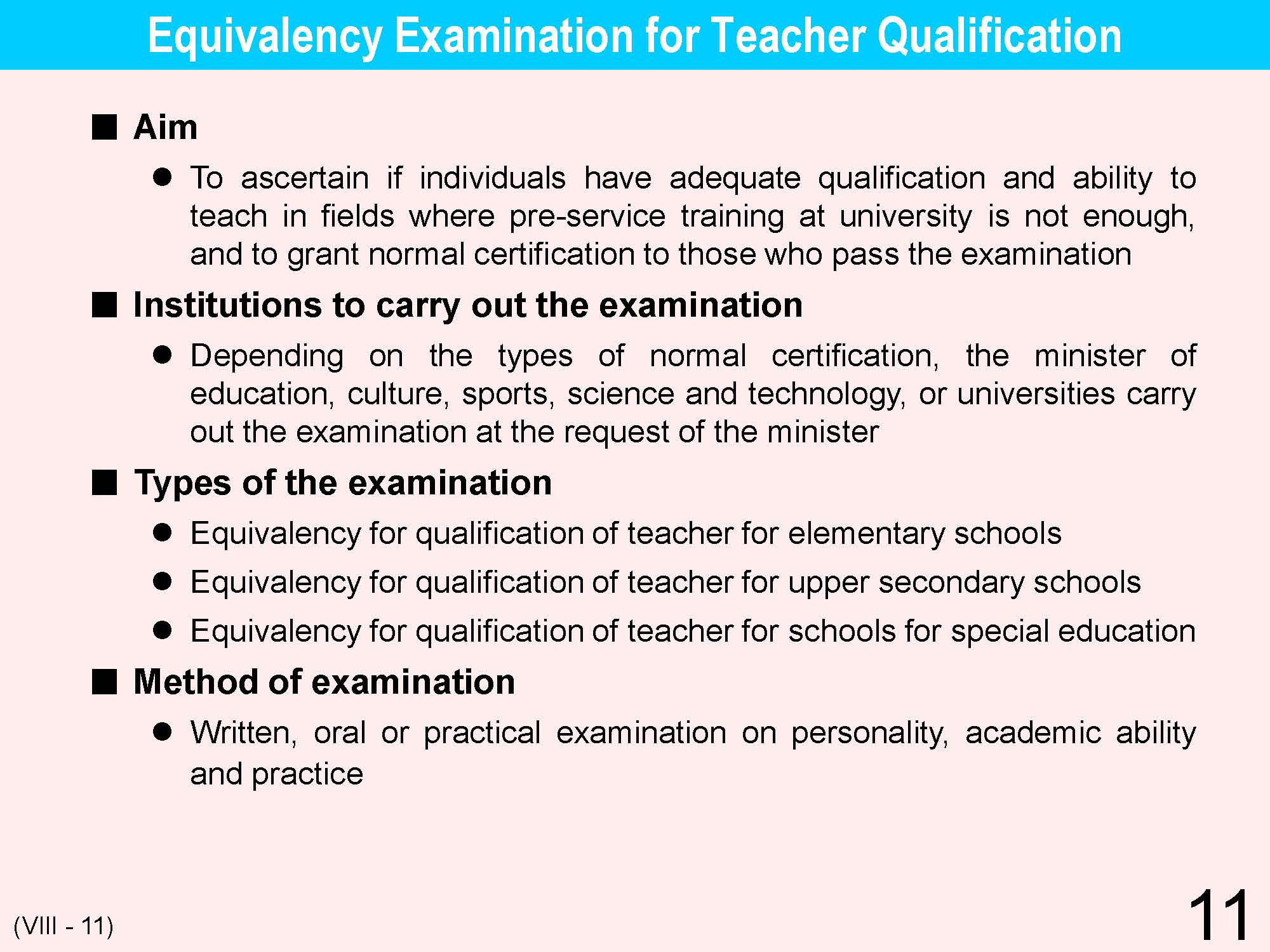 |
The equivalency examination for teacher qualification is the examination to obtain teachers in fields where pre-service training at universities is not sufficient. For elementary schools, the type 2 certification of teachers is given. For upper secondary schools, subjects of the examinations are nursing, information, welfare, judo, Japanese fencing, information technology, architecture, interior, design, information science, and accounting, and the type 1 certification of teachers for the respective subject is given to those who pass the examination. For schools of special education, there are self-reliance activities (education for visually handicapped), self-reliance activities (education for hearing handicapped), self-reliance activities (education for physically handicapped), and self-reliance activities (education for verbally handicapped), and the type 1 certification on the relative subject is given to the ones who pass the examination. |
| 12 | 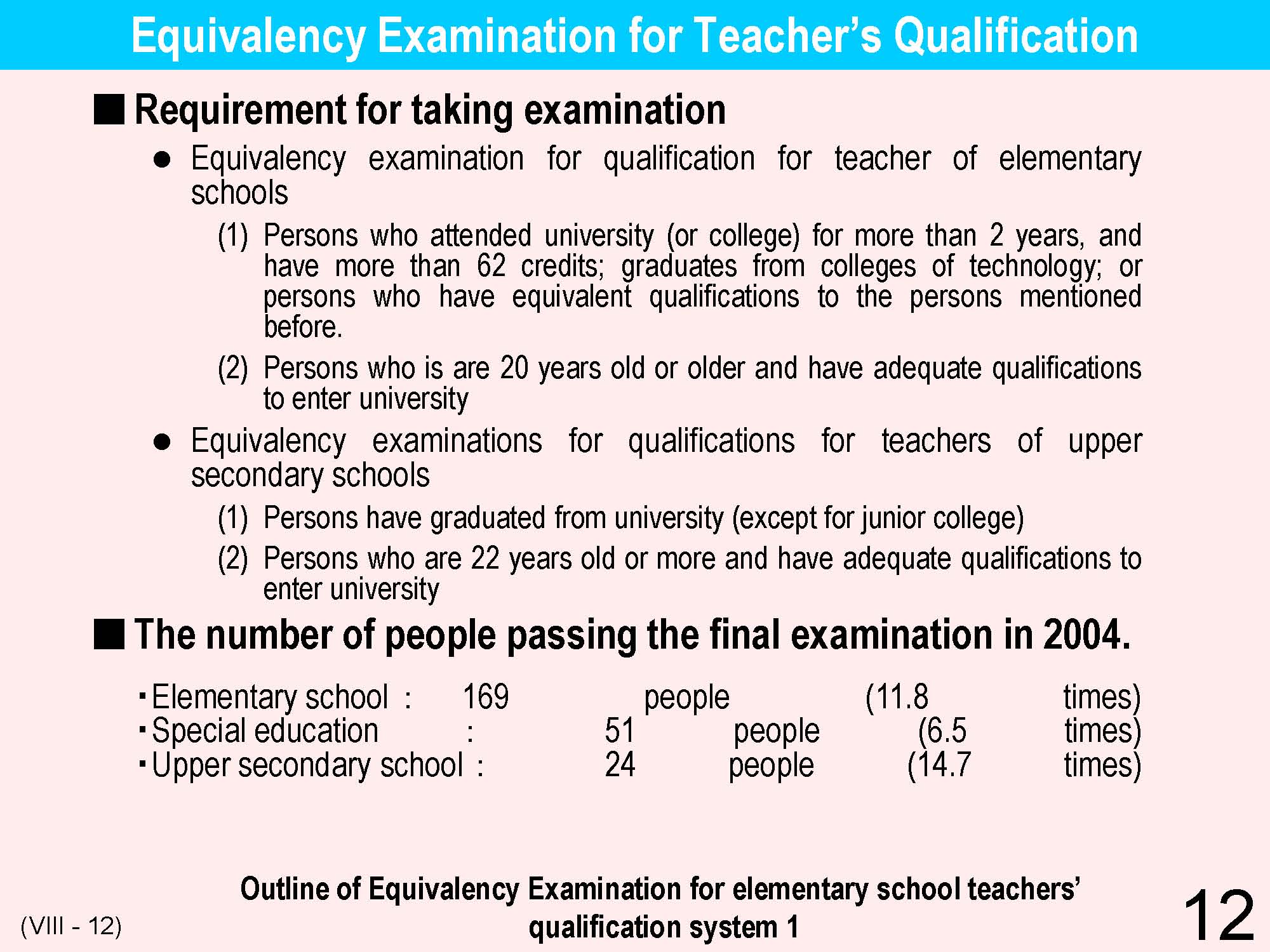 |
In order to qualify as a teacher in Japan, it is basically necessary to attain credits in prescribed subjects at universities. Under the revision of the certification law in 1964, examination of teachers’ qualifications was instituted as a requirement for teachers excluding specific subjects of a technical nature in upper secondary schools (judo, kendo, circulation practice). The 1973 revised certification law attempted to broaden the base of selection of teachers in an evolving educational society by extending the qualification requirement to include elementary school teachers, upper secondary school teachers (nursing, judo, kendo, interior, circulation practice, architecture and design) and special school teachers (nursing training = education for deaf and physically challenged). |
| 13 | 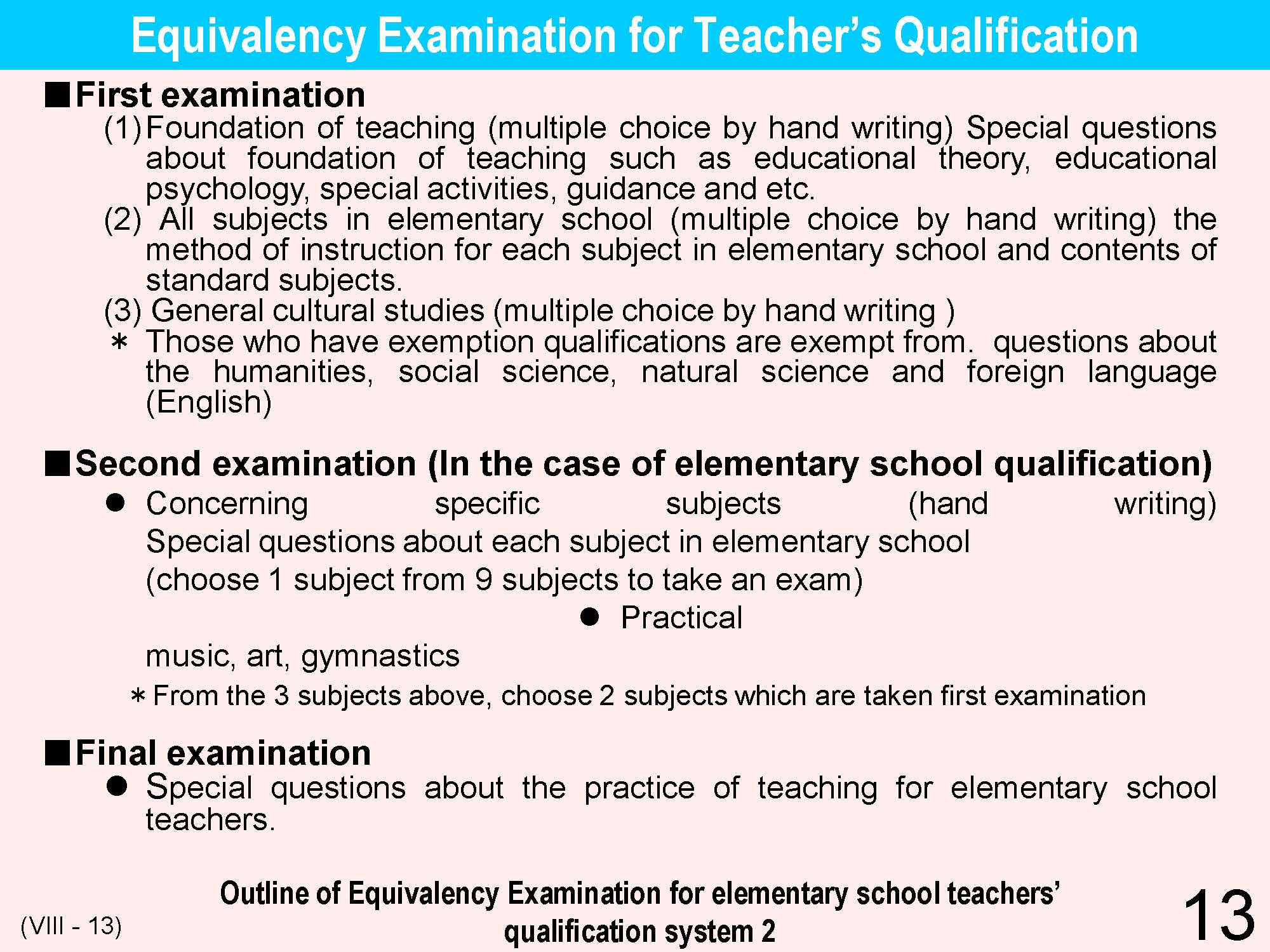 |
The equivalency examination for qualification of teachers for elementary schools has 3 stages. In the first examination, there are questions regarding educational / cultural subjects, educational guidance for subjects, basic subject contents, and subjects on general teaching. The second examination consists of questions on advanced matters subjects and practical examination, and the final examination concerns matters pertaining to the practice of teaching. There were 169 people who passed the equivalency examination for qualification of teachers for elementary schools in 2004, and only 1 in 11.8 applicants passed the examination. |
| 14 | 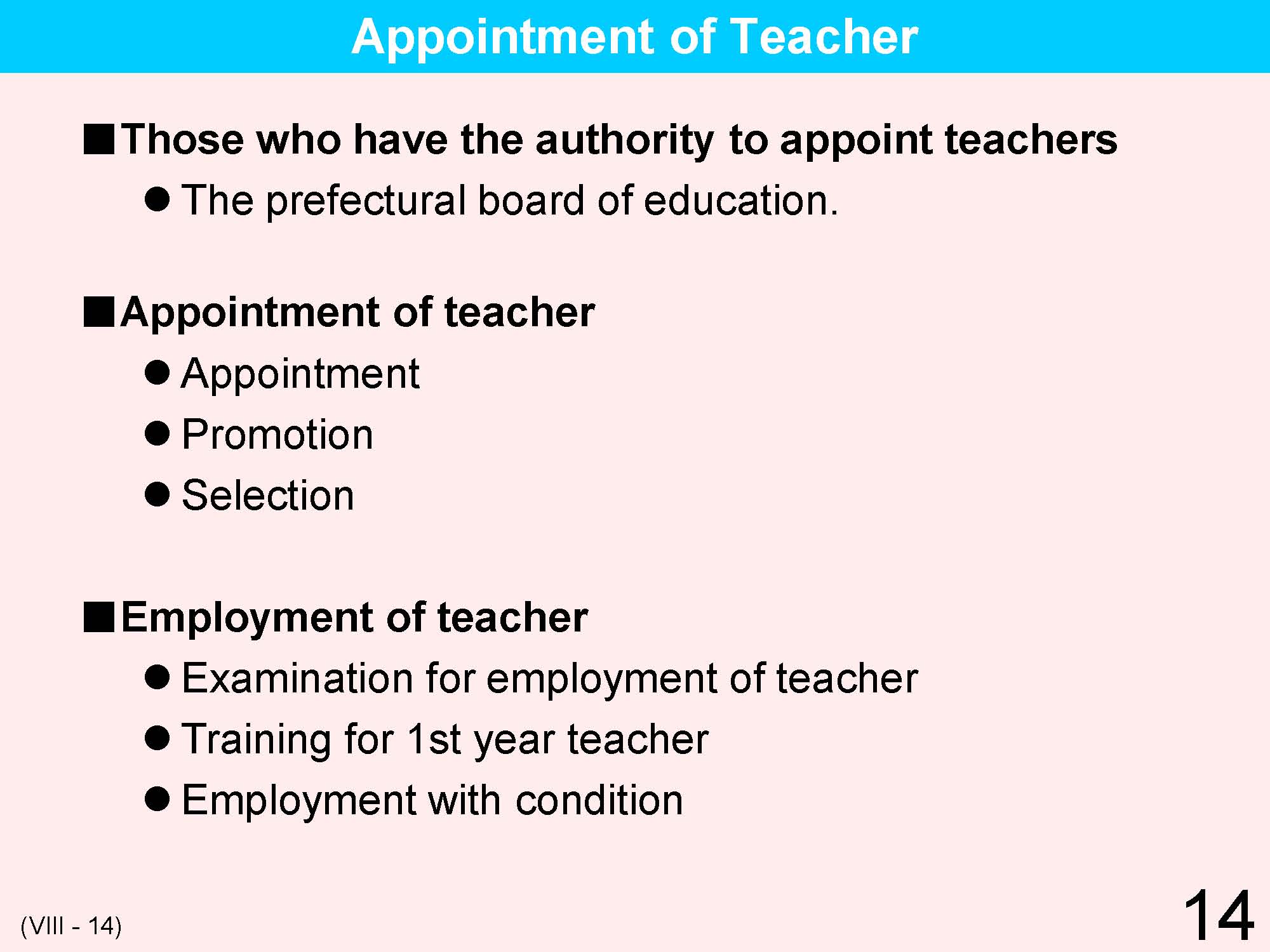 |
Appointment is a generic term for employment and promotion. As in the case of general administrative officers, teachers must be appointed based on their exam scores, work records and other abilities. However, the way teachers’ examinations are administered is different from that for general administrative officers. Teachers’ examinations are not competitive but selective (Article 13 Clause 1, Special Law for Public Education Workers). Selection is made by judging achievements, experience, humanity, practical skills and experience and physical strength on the basis of specific standards. In public schools, aside from schools attached to specific universities, the superintendents of the boards of education make the selection of teachers. In schools attached to universities, the presidents of the universities handle this appointment task. In national universities, excluding schools attached to universities, the Minister of MEXT handles appointments. (Article 13 Clause 1, the Special Law for Public Education Workers) The examination for employment of teachers is designed to assess the ability, will and commitment to the mission as a teacher of individual candidates through written, oral and practical examinations. For the first year of teaching, prospective teachers are employed on a conditional basis, and during that period they undertake training for 1st year teachers. |
| 15 | 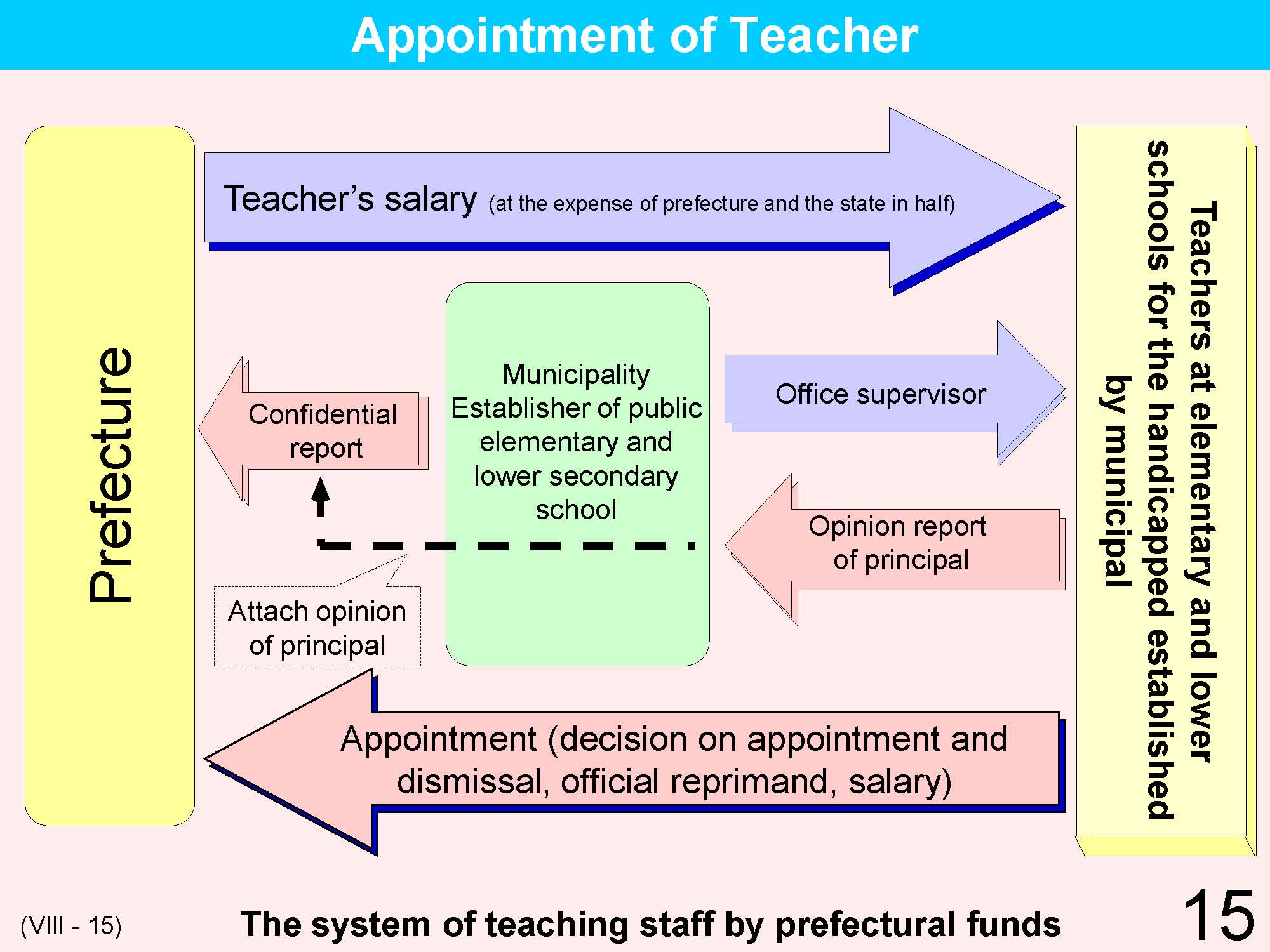 |
The personnel and financial aspects of educational staff are supported by prefectural funds, covering such aspects as appointment (employment, promotion), demotion, and dismissal, for example. The system of management by establisher for management of public schools established by municipalities does not include the right of deciding on personnel s. Prefectural / appointed city boards of education exercise such personnel rights. The reasons for this situation are the fact that these boards of education fund half of the teachers' salaries, and by handling disposition of teachers they are better able to better and more broadly arrange needed personnel exchanges. However, since it is individual school principals who observes teachers on a daily basis, and know their performance more intimately, opinions of the principals are respected in decision-making on personnel affairs. (Law on local educational administration, article 38) Currently, from the perspective of decentralization, there is a widespread view that municipal boards of education should have greater rights in handling educational personnel affairs that are supported by the prefectural funds. |
| 16 | 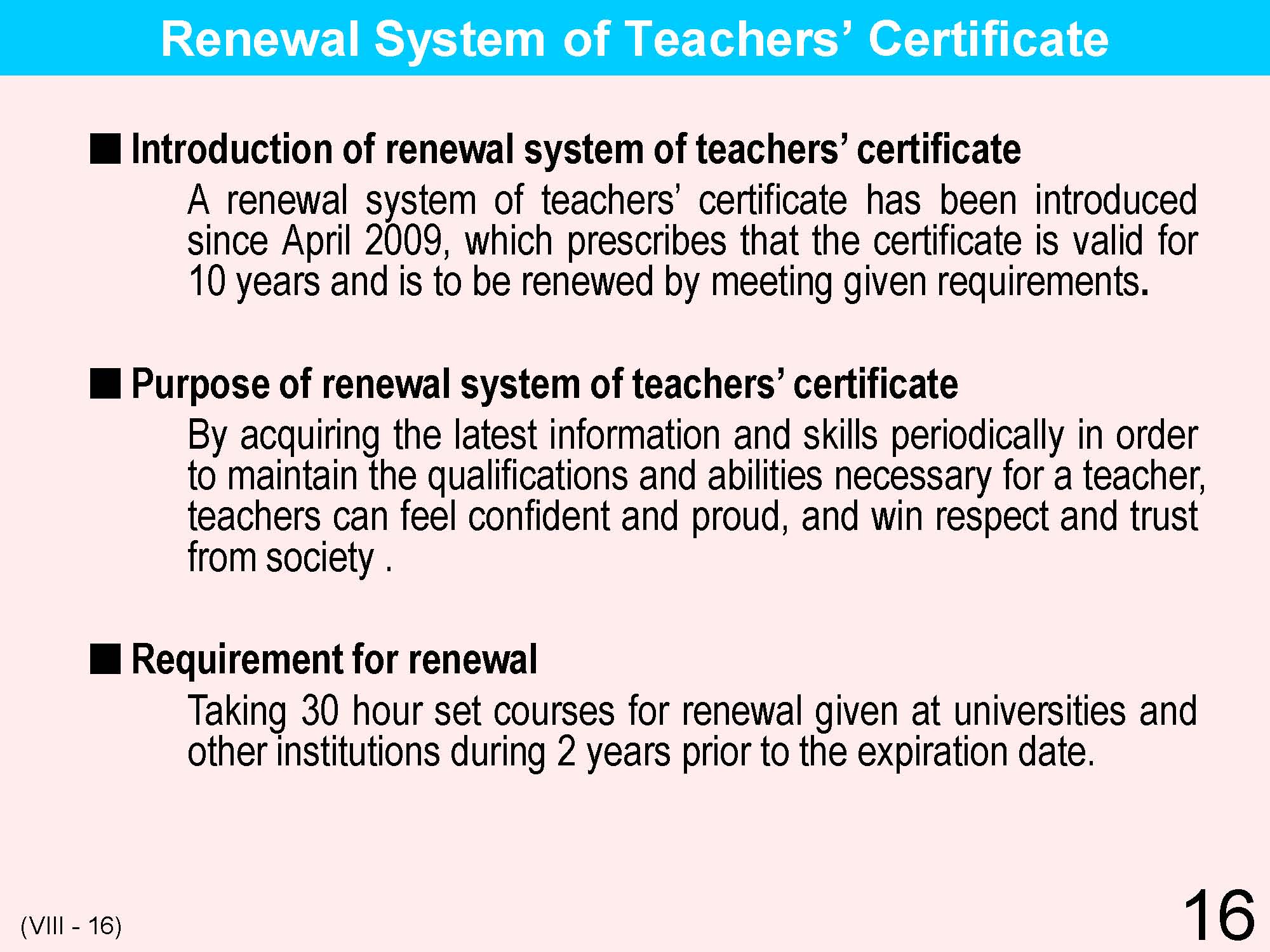 |
The 30 hour renewal courses consist of (1) topics of reflection on teachership, and understanding changes of children, trends in educational policies and coordination and cooperation in and out of school (mandatory areas: more than 12 hours), and (2) topics of teaching subjects, guidance to students, and other topics to enrich education (elective areas: more than18 hours). |
| 17 | 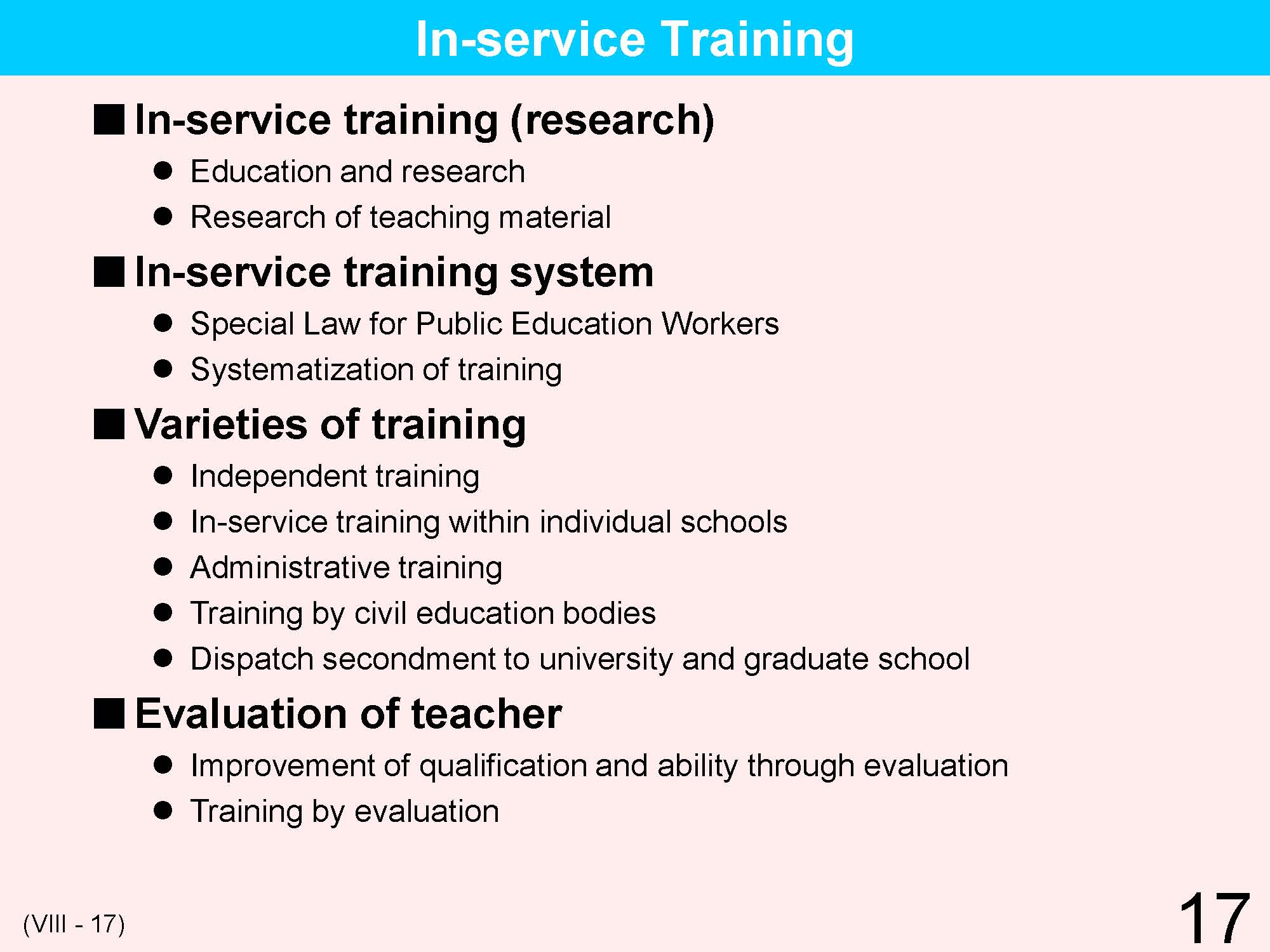 |
The training of teachers and teaching research are necessary in order to prepare such educational activities as classes and guidance, to solve problems and tasks in the process of carrying out classes and guidance, and to be aware of evolving changes in education and then to reflect these changes in educational activities. A Japanese word for training “kensyu” is derived by adding “syuyo” (cultivation of the mind) and “kenkyu” (research). Cultivation of the mind means to deepen the awareness of individuals as teachers, to inculcate responsibility towards guardians of children and society, and to fulfil vocational and social responsibilities. Since the aim of education is to teach knowledge and techniques to children depending on their levels of development, it is necessary to undertake research on teaching materials as well as research on children. Therefore, undertaking training is considered as a part of teaching duties as defined in the law on special cases of public servants who are educators. Training should basically be carried out independently. However, given limitations and constraints, and because of the need for consistency in educational administration of schools, opportunities such as in-service training are provided within schools, administration training as well as advanced (“dispatch”) training in university and graduate schools. Training based on educational evaluations has also been introduced recently. |
| 18 | 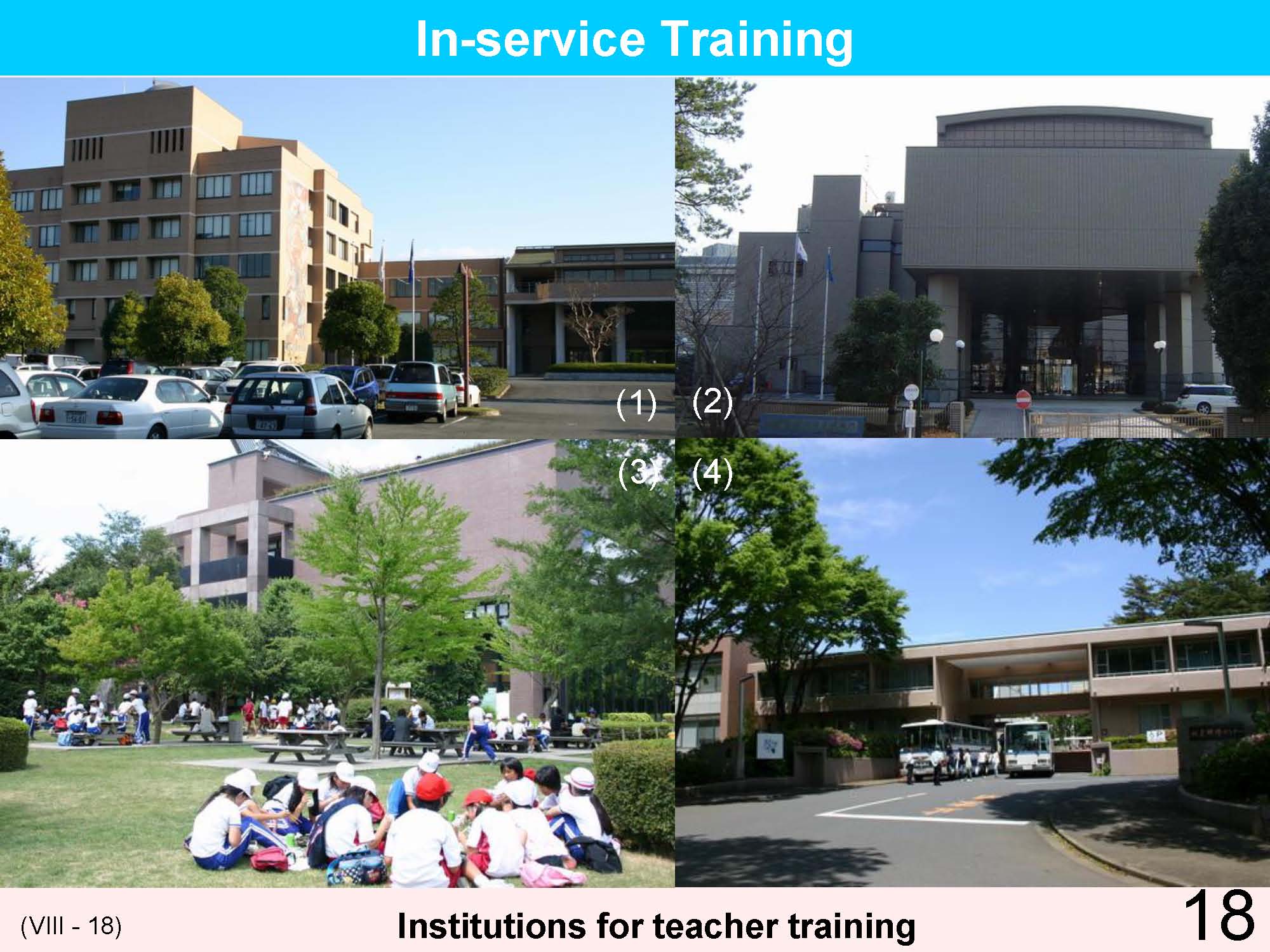 |
(1) Prefectural education training center (2) Municipal institute of education (3) Prefectural natural museum (4) Teacher training center (an independent administrative institution) |
| 19 | 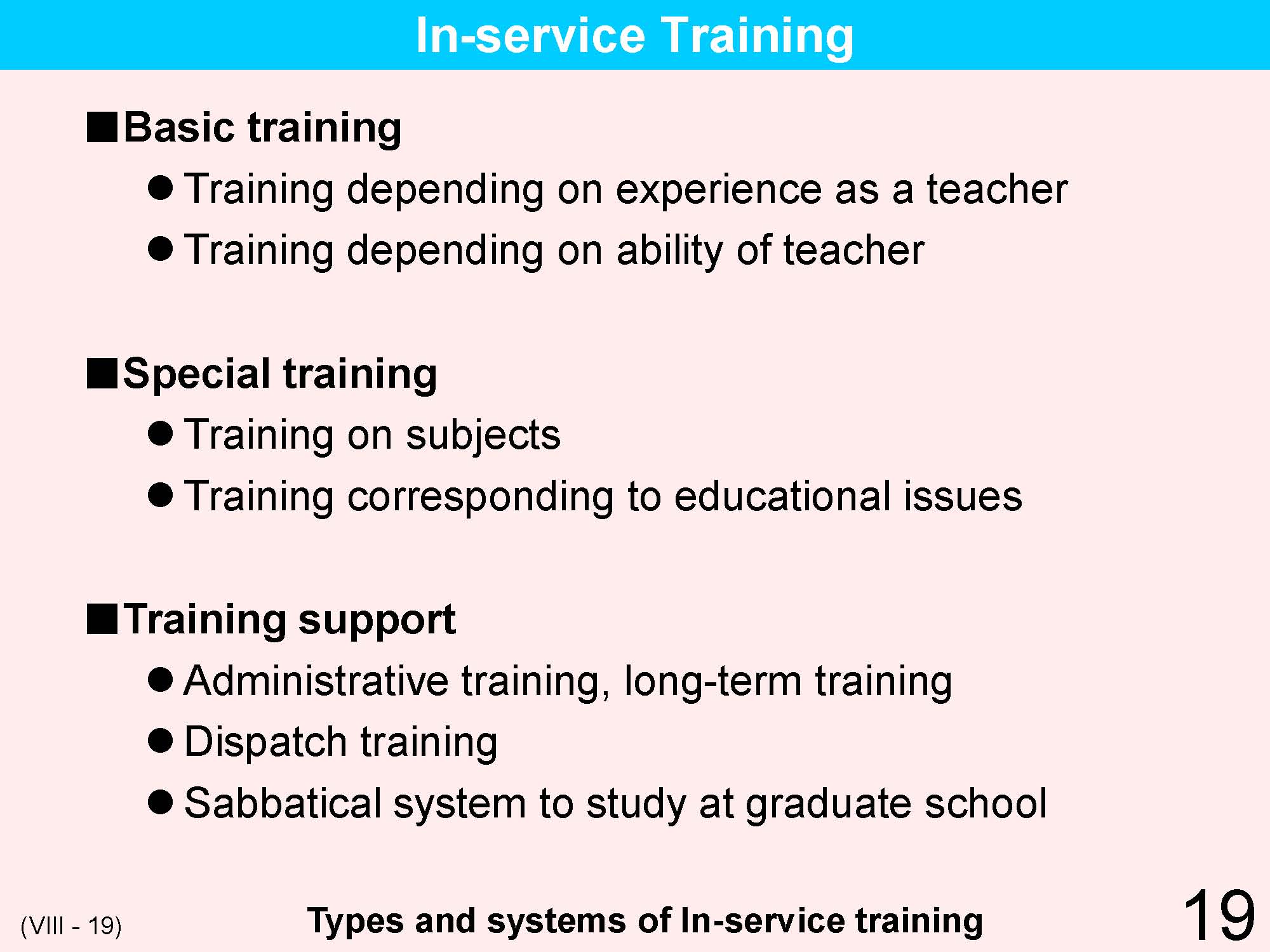 |
For training conducted by boards of education and teachers' training centers, there are both basic types of training such as training depending on teaching experience (length of teaching) and teaching ability, and special trainings such as training on subjects and training corresponding to educational tasks. The forms of training are classroom type training such as through lectures and practice, and discussion type training where teachers submit educational tasks and exchange opinions about them. In central training, teachers are provided lodging over a longer term training that spans around 3 weeks. While training involving lodging may be conducted by the boards of education, it typically involves short-term training. Boards of education conduct training on their own as well as support the secondment and dispatch of teachers to universities and private companies. Recently, the sabbatical system has been introduced that facilitates study by teachers at graduate schools. |
| 20 | 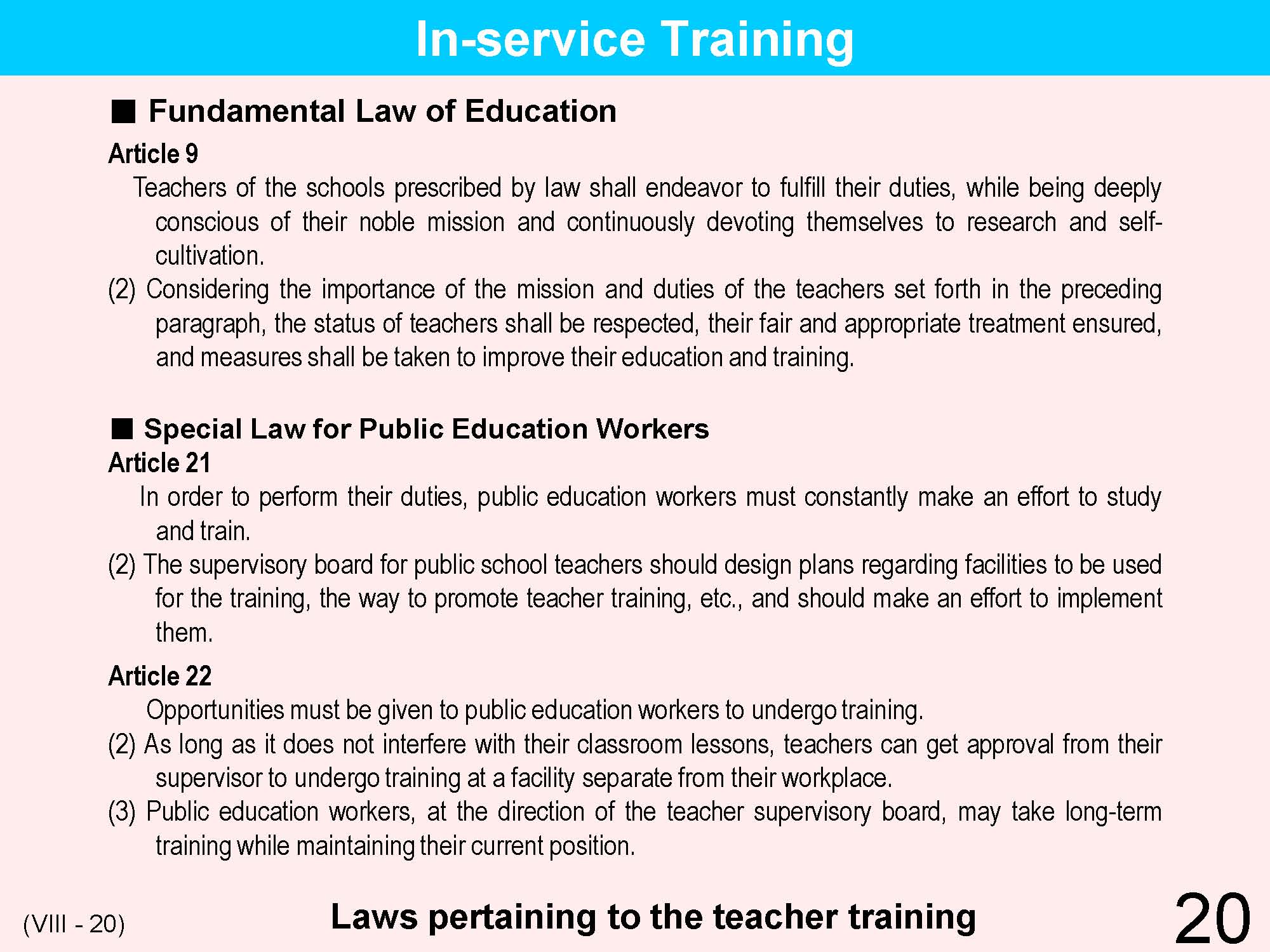 |
The Fundamental Law of Education revised in 2006 prescribes it is a duty for teachers of the school to devote themselves to research and self-cultivation. In view of the importance of the teaching profession, which differs from that of other public servants, the Special Law for Public Education Workers prescribes that it is a duty for teachers of the school to devote themselves to research and self-cultivation, and the board of education, the authorities to appoint and dismiss teachers, must develop the conditions for training teachers. At the same time it allows teachers to receive various trainings with their status guaranteed. |
| 21 | 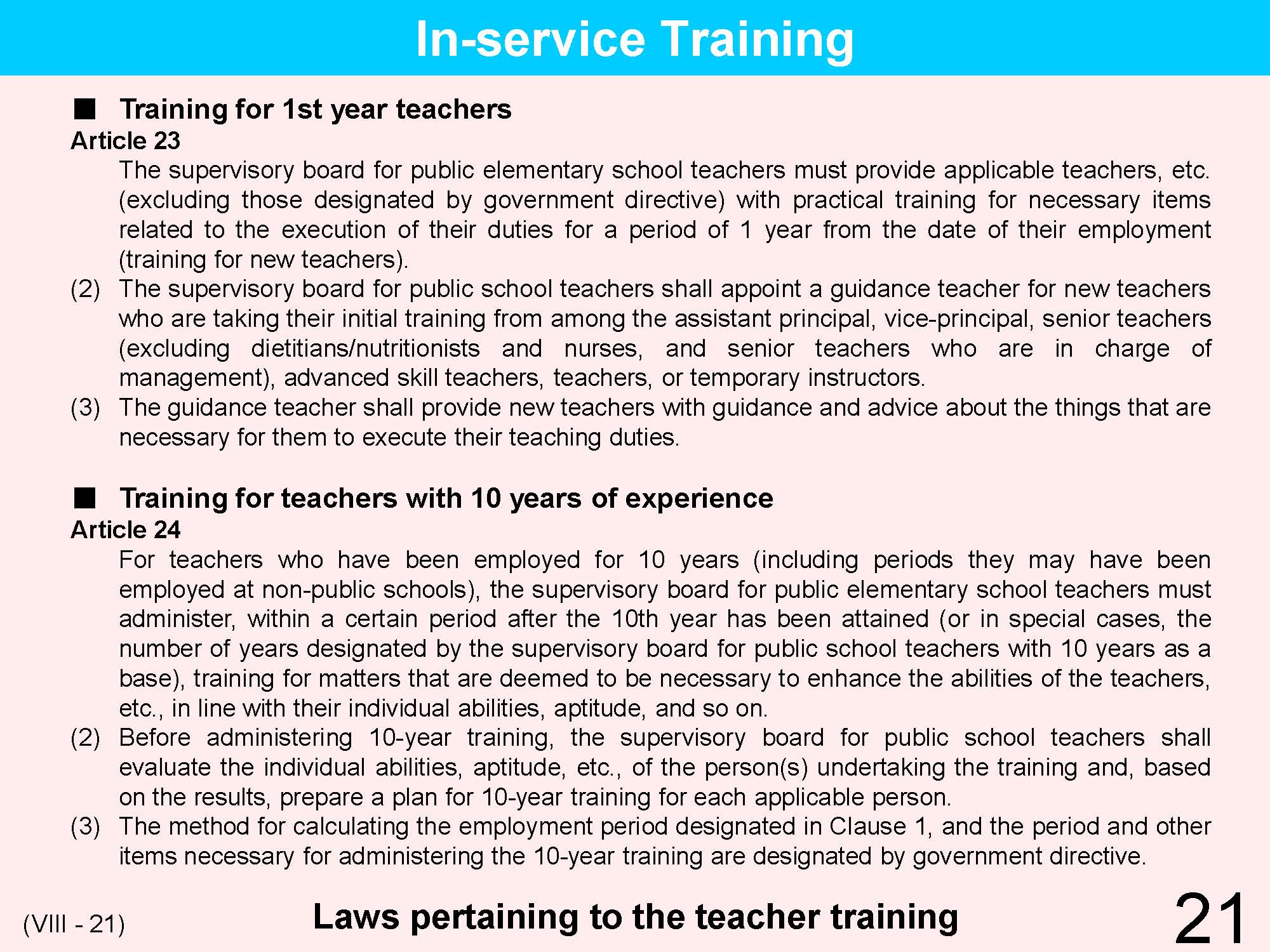 |
Teachers of public schools are employed conditionally for one year from the date they are first employed, and during that time they must receive initial training prepared by the authorities to appoint and dismiss teachers. Those with ten years experience as a public school teacher must receive training for teachers with ten years teaching experience prepared by the authorities to appoint and dismiss teachers. |
| 22 | 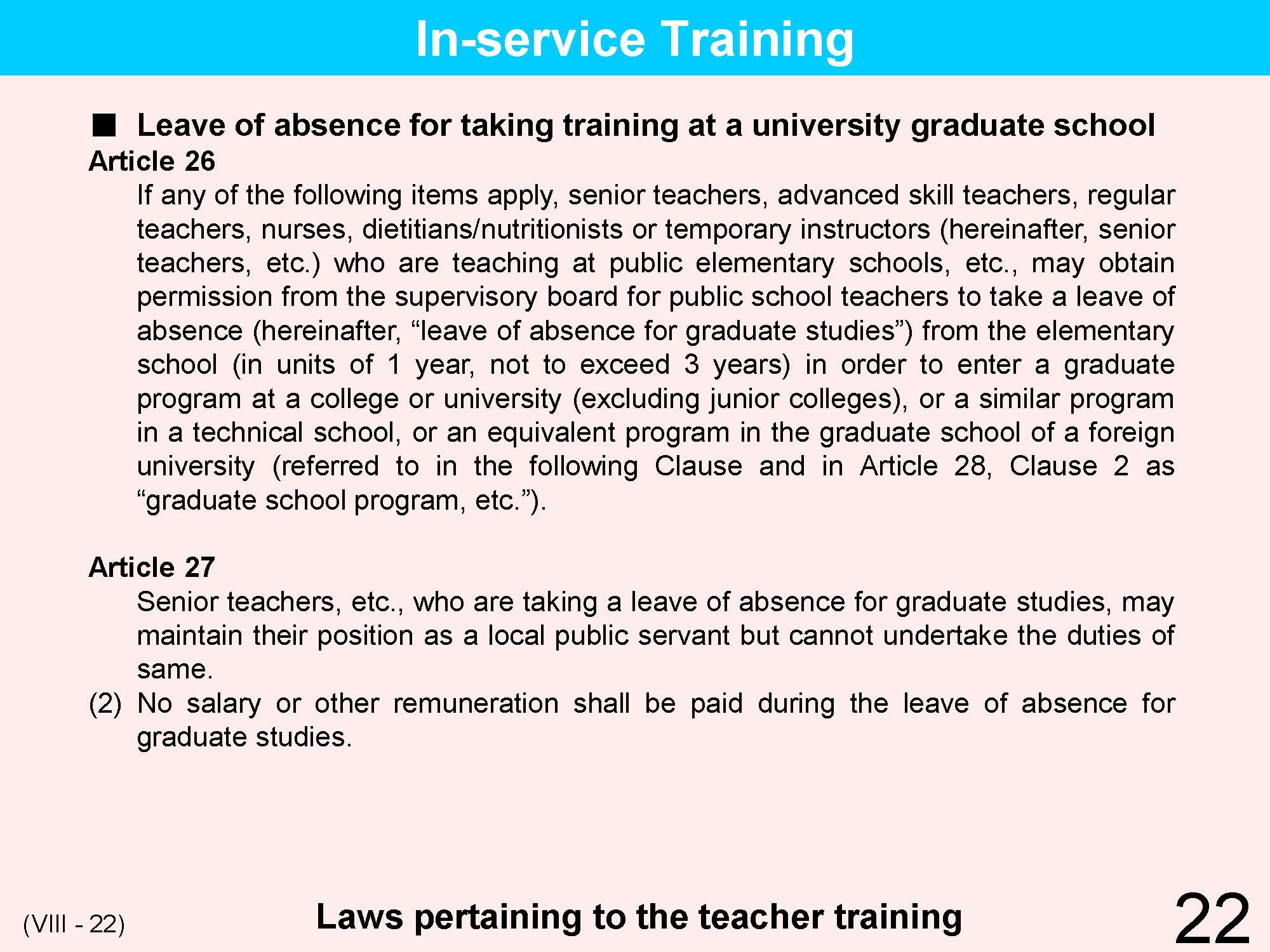 |
Teachers of public schools can have a sabbatical of one to three years to study at graduate school at home or overseas with permission from the authorities to appoint and dismiss teachers. During the sabbatical the teacher is guaranteed the status of a public servant, but does not receive a salary. |
| 23 | 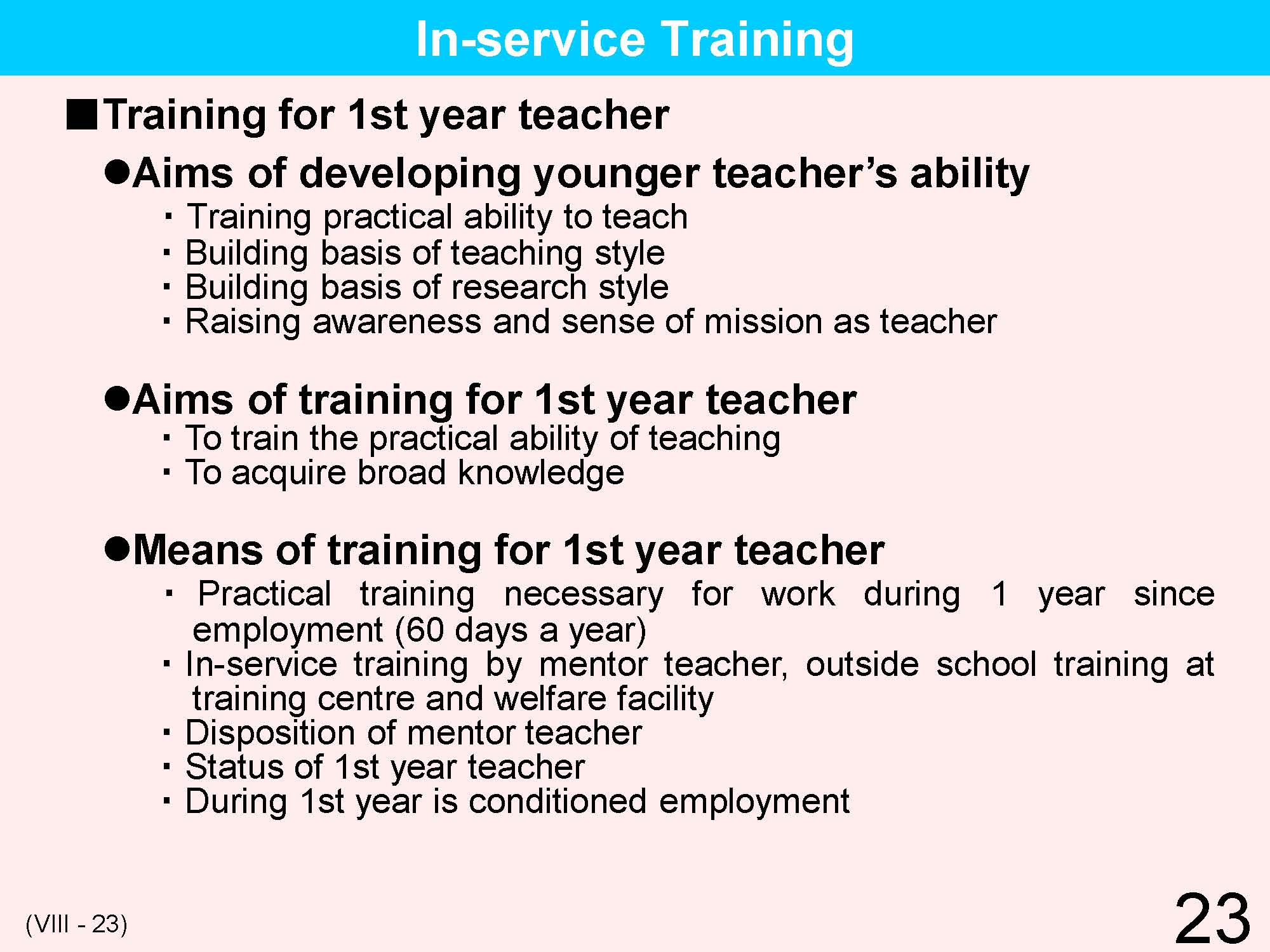 |
Young teachers, especially 1st-year teachers have various worries, difficulties and issues at school. Capacity development is needed for young teachers to become independent teachers. The first school for young teachers to be assigned to is called a “second school”, and this illustrates how important the first school to which a teacher is assigned to is. Previously, 1st-year teachers needed to do the same work as teachers with 10 years of teaching experience. They also were treated as independent teachers. However, since 1st-year teachers do not have sufficient teaching ability and experience, training for 1st-year teachers was implemented. In such training, 1st-year teachers are trained both within and outside of their schools for 60 days. Also, the status of 1st-year teachers is that of conditioned employment. Capacity development for 1st-year teachers cannot be achieved in a single year, and take approximately 3 years. During this period of time, the role of in-service training within schools and the leadership provided by principals is critical in nurturing young teachers’ development. |
| 24 | 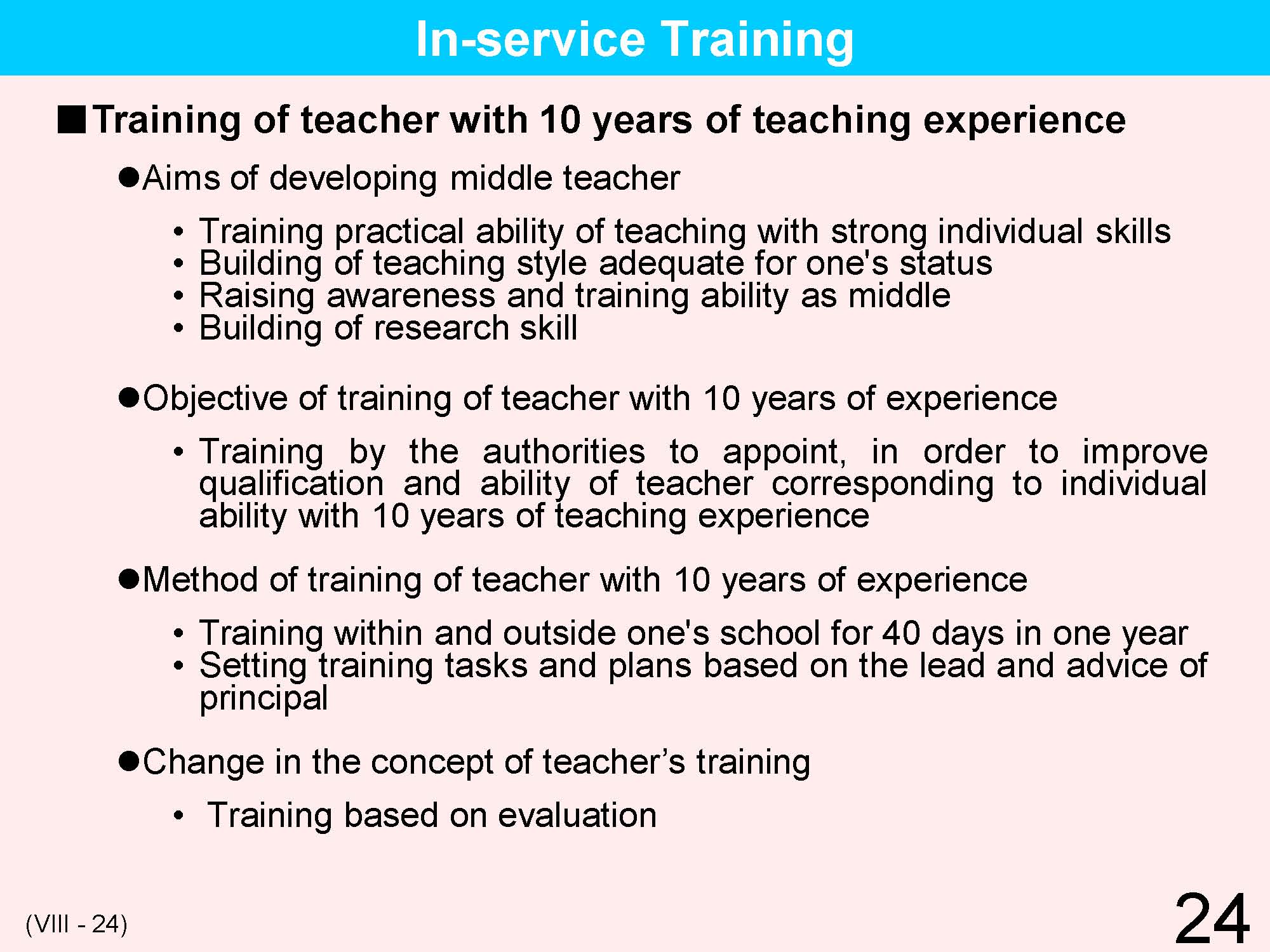 |
Expectations regarding middle school teaching options have expanded following the development of the program for autonomous school management. These expectations concern management staff, leadership positions in sub organizations and guidance teachers. Middle schools need to provide an environment where school tasks can be carried out and problems solved through improved school management. Middle school leadership is divided into management-type leaders and specialist-type leaders. The training of teachers with 10 years of teaching experience has been systematized. Such training is authorized by the relevant authorities in order to improve the qualifications and abilities of teachers with 10 years of teaching experience, corresponding to their individual capacities. Such training is based on evaluations of teachers performance and skills, which represents a change in the style of training compared to the past. In formulating training tasks and training plans for individual teachers, other teachers also participate in training and in the process of providing guidance and assistance. |
| 25 | 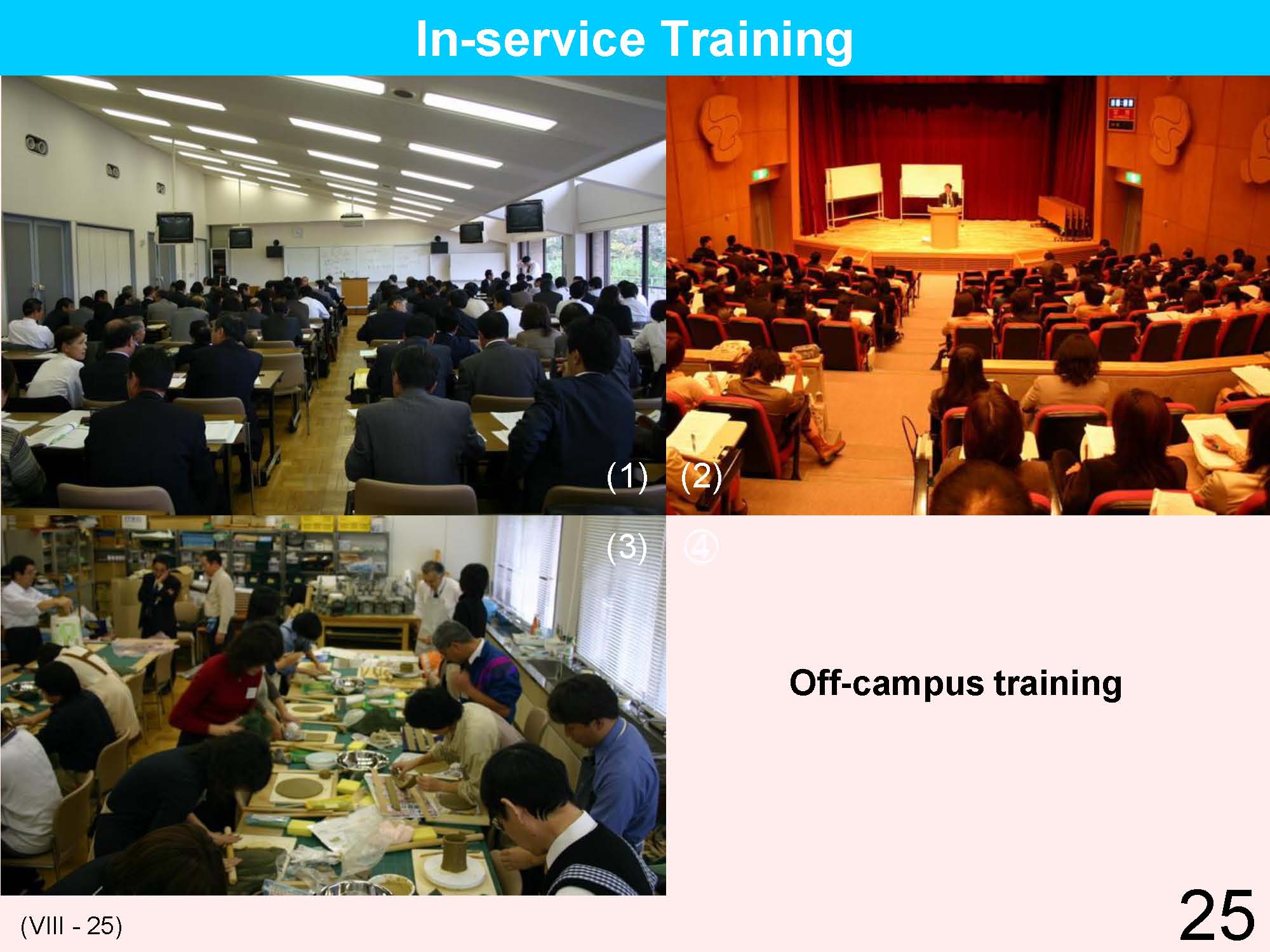 |
(1) Initial training for new elementary school principles, “About school management (seminar)”, November 2004 (2) Training for teachers with ten years teaching experience in elementary schools, “About student guidance (lecture)”, October 2004 (3) In-service training on subjects for elementary and secondary school teachers, “Development of teaching materials and teacher’s skills to teach Art (work-shop)”, November 2004 |
| 26 | 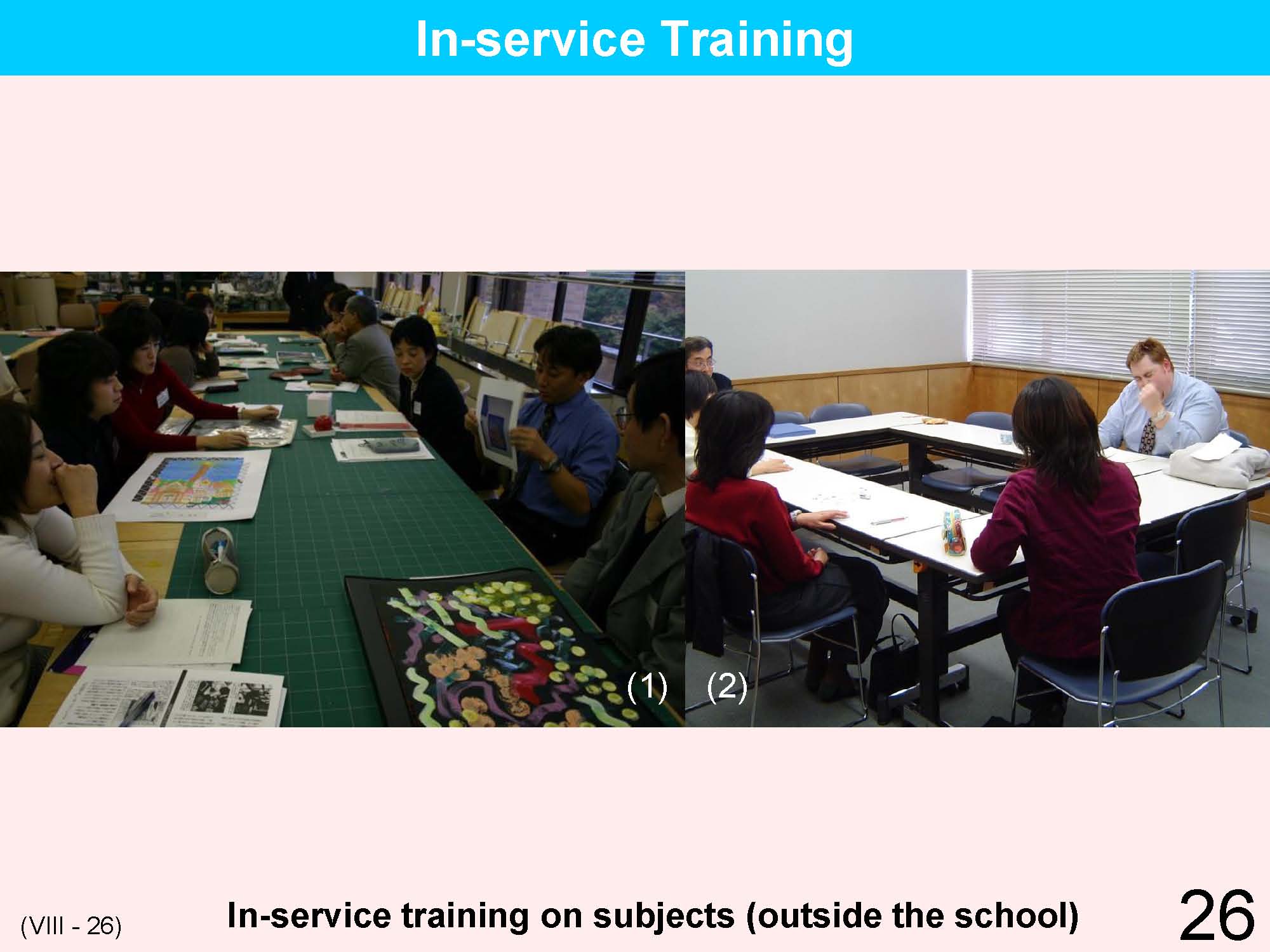 |
(1) In-service training on subjects for elementary and secondary school teachers, “To begin appreciation regarding things at hand (work-shop)”, November 2004 ; teachers are conveying their impressions and opinions about students’ works. (2) Special training for elementary and lower secondary school teachers, “English conversation”, February 2004 |
| 27 | 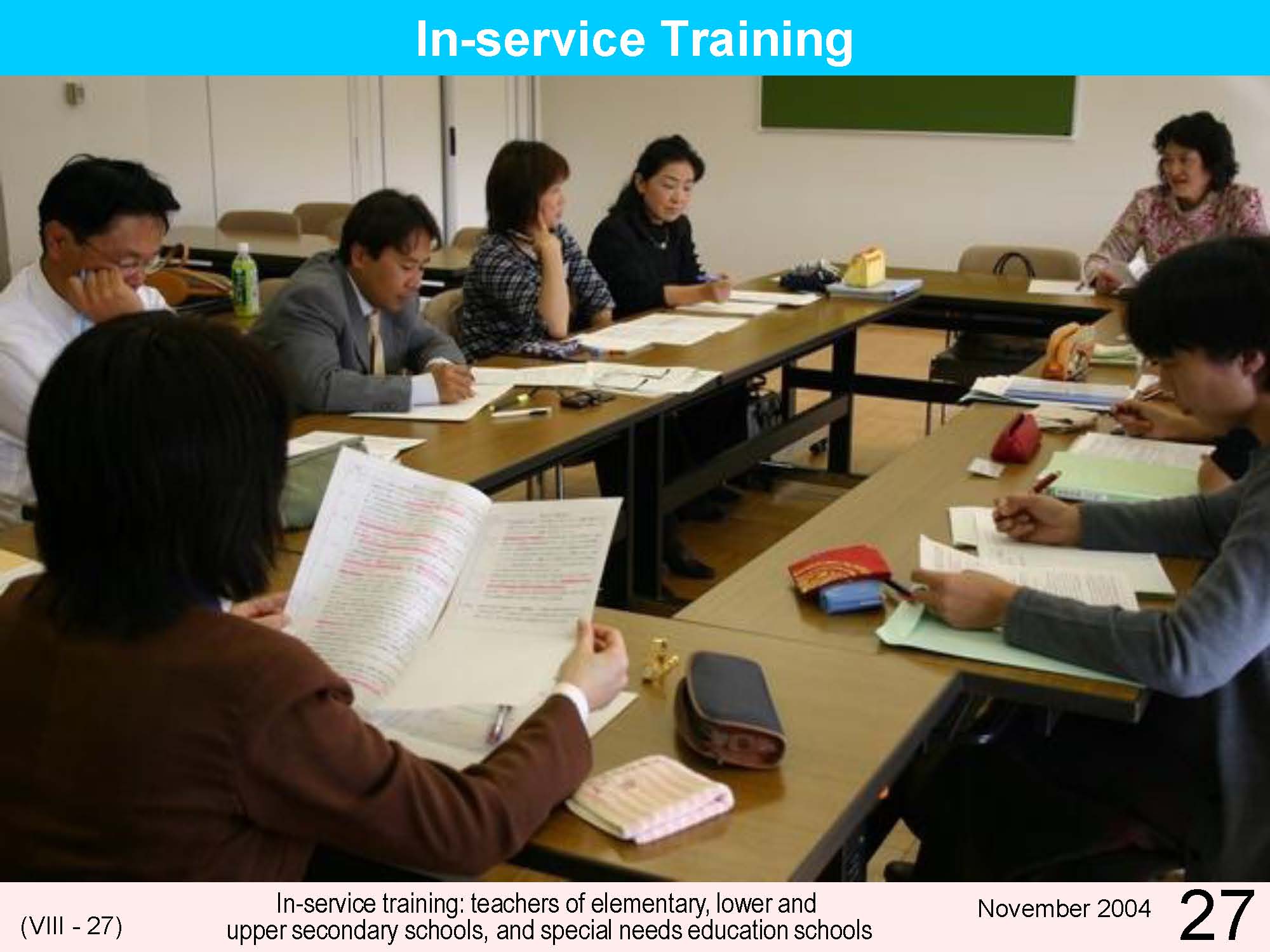 |
As there are few opportunities for teachers from different educational levels to engage in discussions with each other, through municipal level training opportunities are provided for teachers from various educational levels (elementary, lower secondary, upper secondary and special needs education schools) to participate in training together. |
| 28 | 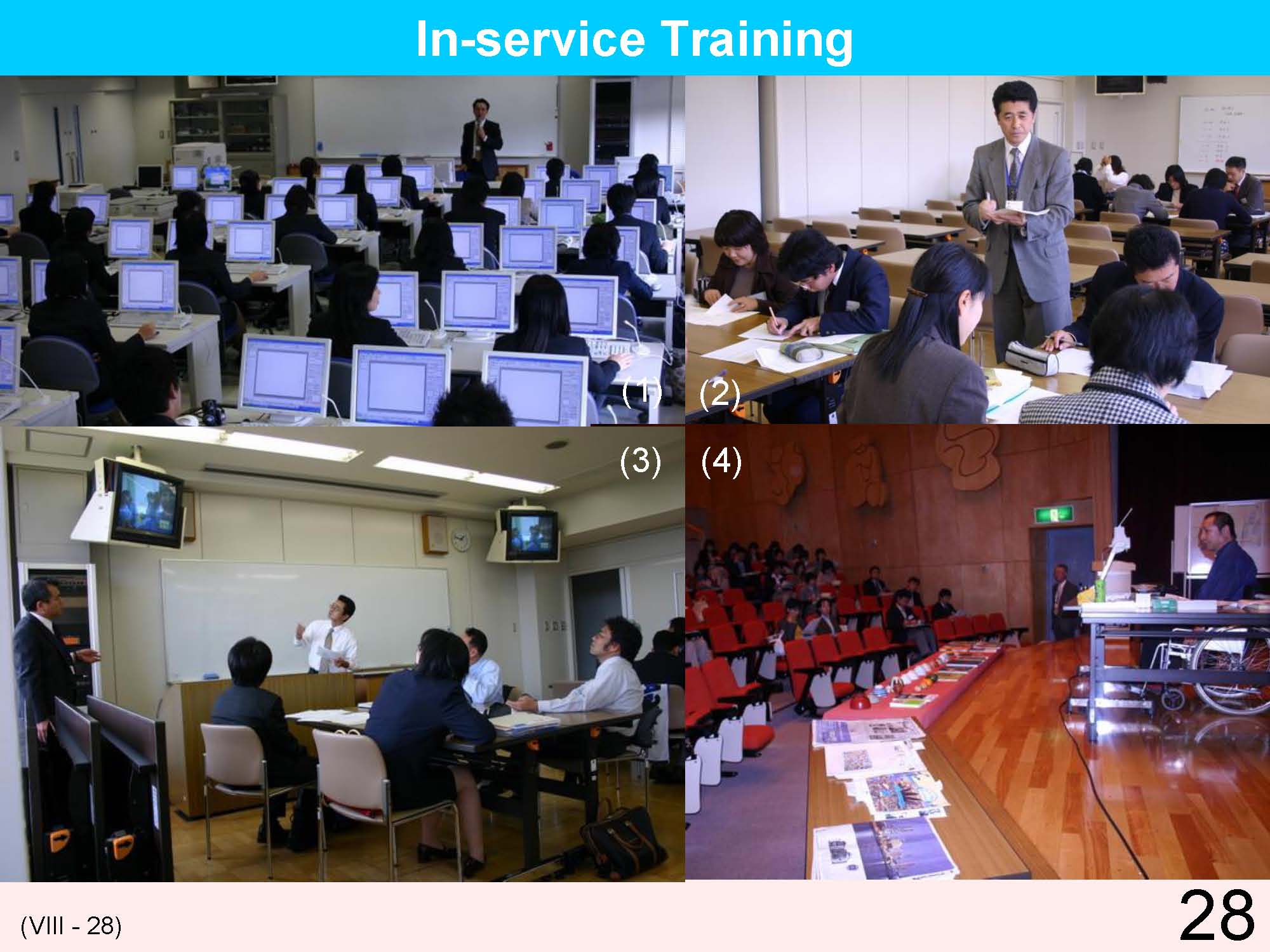 |
(1) Initial training for new elementary school teachers, “training for educational information”, October 2004 (2) Training for teachers with ten years experience in lower secondary schools, “About student guidance (discussion)”, October 2004 (3) Training for teachers with ten years experience in lower secondary schools, “About special activities (discussion)”, October 2004 (4) Training for teachers with ten years experience in elementary schools, “About student guidance (lecture)”, October 2004 |
| 29 | 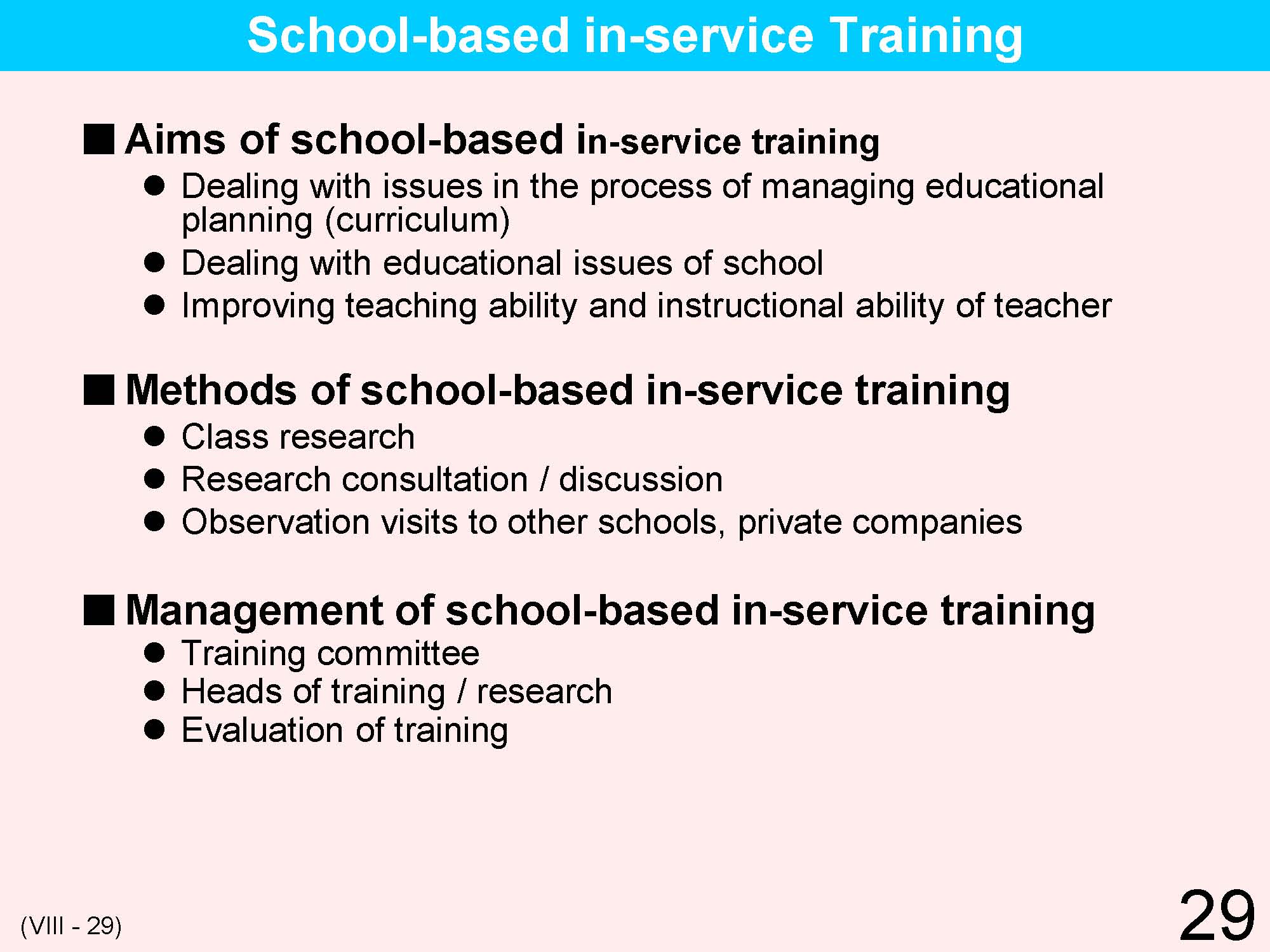 |
School-based in-service training is the tradition and culture of Japanese schools that has been conducted for long time. The aims of school-based in-service training are to cultivate awareness and commitment of individuals to their mission as teachers, to improve teaching abilities of teachers, to deal with children and student issues, to solve educational tasks at schools, to adjust teaching practices and management to correspond to new educational reforms, and to implement research as appointed by boards of education. Especially lesson study in which teachers consult each other after observing each other’s class has a significant implication in sharing educational issues of school and solving problems. School-based in-service training is incorporated into school management plans. Training committees are established as an institutions for sharing of school duties and where where individual responsibilities are made clear. When carrying out in-service training, the roles and leadership of the head of such training / research is an important element. It is necessary to place and adequate number of capable people in such committee positions in order to ensure that the development of training programs actually happens. For school-based in-service training, it is a basic tradition that teachers should arrange such training independently. There is some concern that school-based in-service training arranged by teachers independently does not occur very frequently, although it is recognized that it is good to conduct school-based in-service training as an organization. |
| 30 | 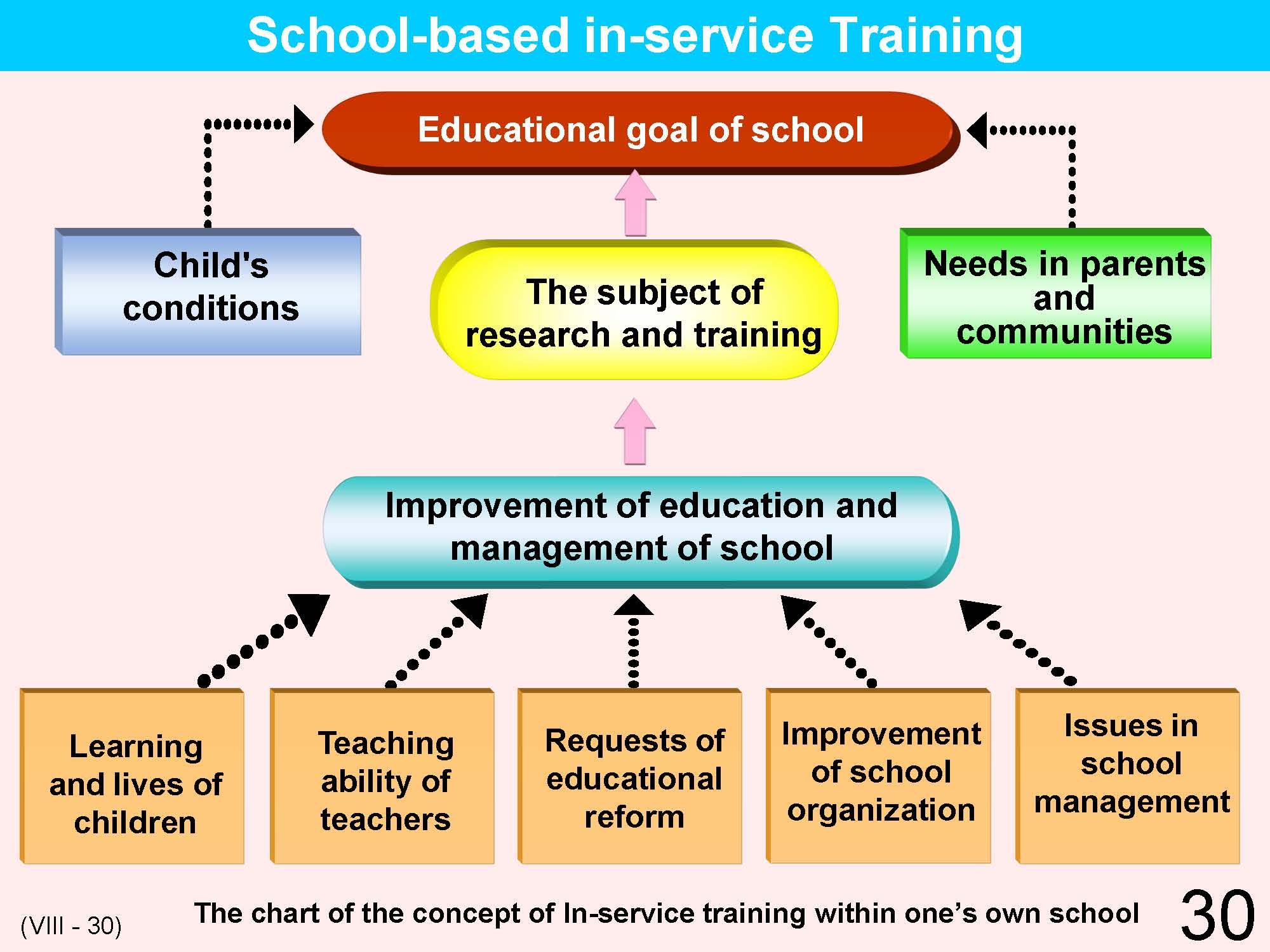 |
Under school-based in-service training, the research theme generally focuses on improvements in policies regarding educational practices within the whole school, consistent with with the school educational goals for the year. Specifically, such training helps to explore and to provide solutions to such aspects as educational guidance, subjects for student instruction, and improvements based on evaluations. |
| 31 | 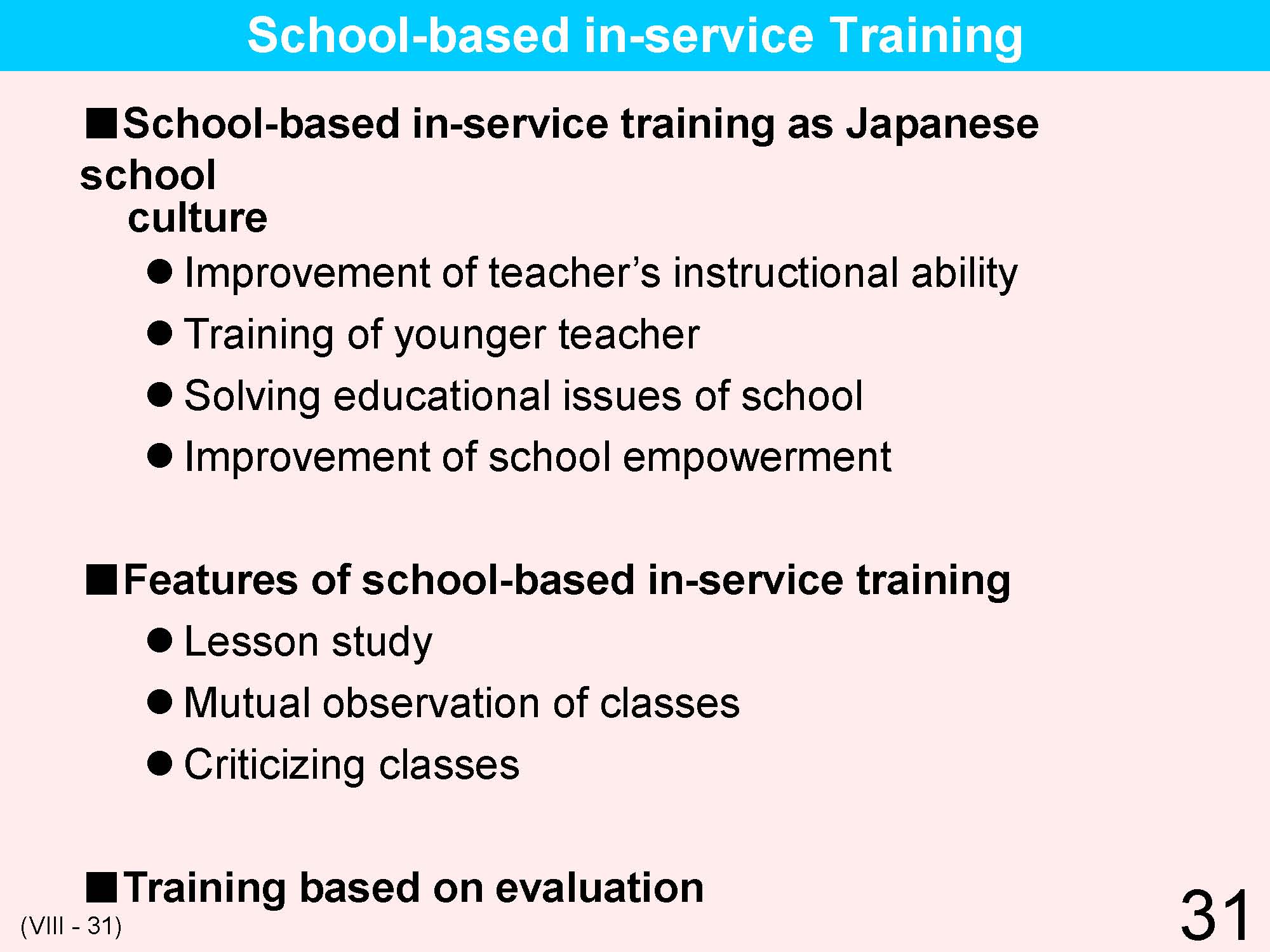 |
Planning, enforcing and managing school-based in-service training is conducted through the training committee institution. The training committee promotes the in-service training as its core management task. Since the school-based in-service training is a part of school management plan, principles of management and education propounded by the school principal should be reflected. The teacher appointed as head of training leads the training committee, and promotes in-services training. The school head of training needs to have leadership skills to organize and implement school training plans based on the goals of the school principal. The organization and leadership ability of the head of training is critical in in-service training management. When it is necessary, visiting lecturers such as head of guidance of board of education, teachers of other schools, or researchers are invited to in-service training to get advice from them. |
| 32 | 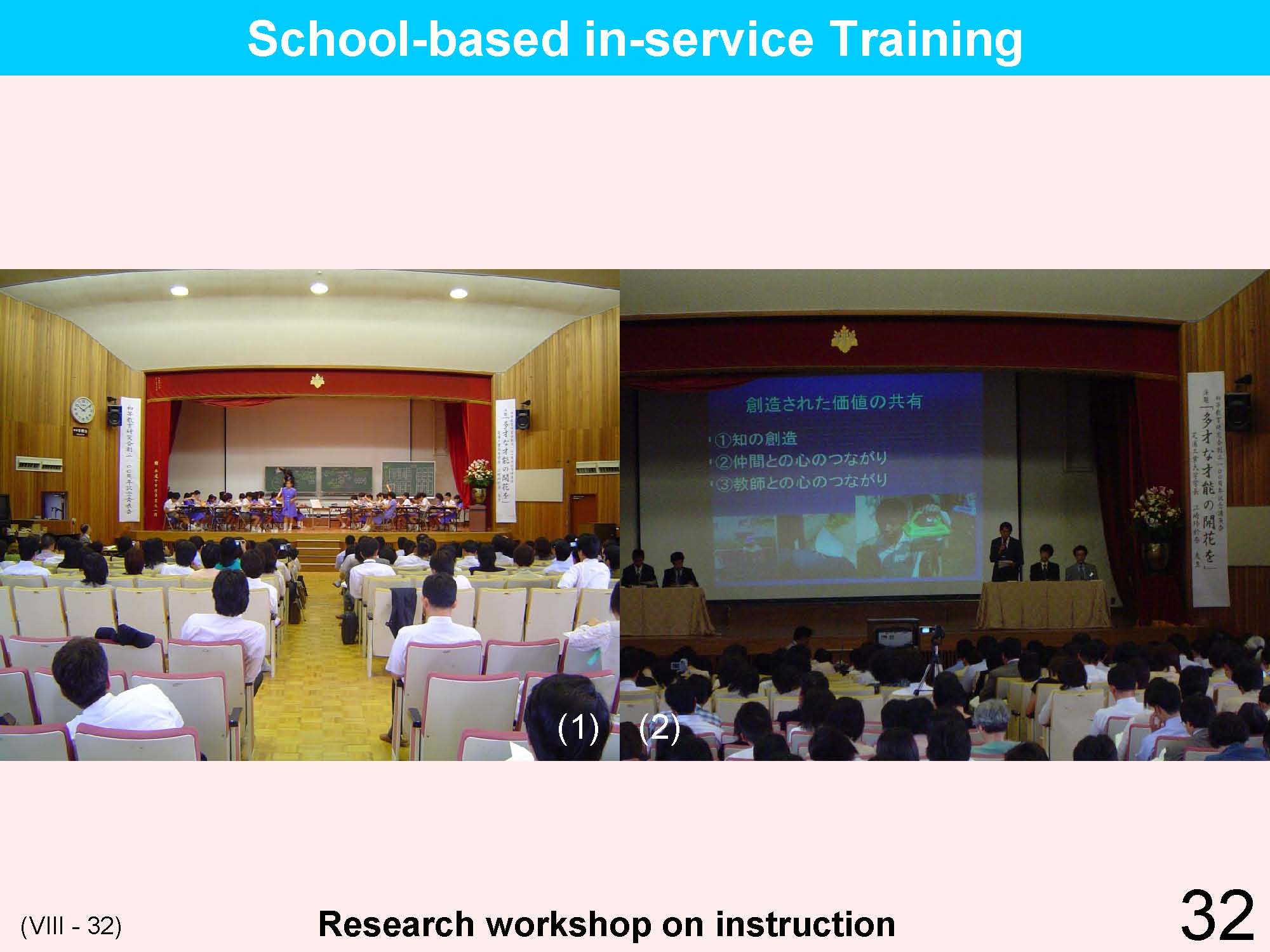 |
(1) Demonstration class (Arithmetic “square measure”), 5th grade, June 2004 (2) Presentation of research, June 2004 |
| 33 | 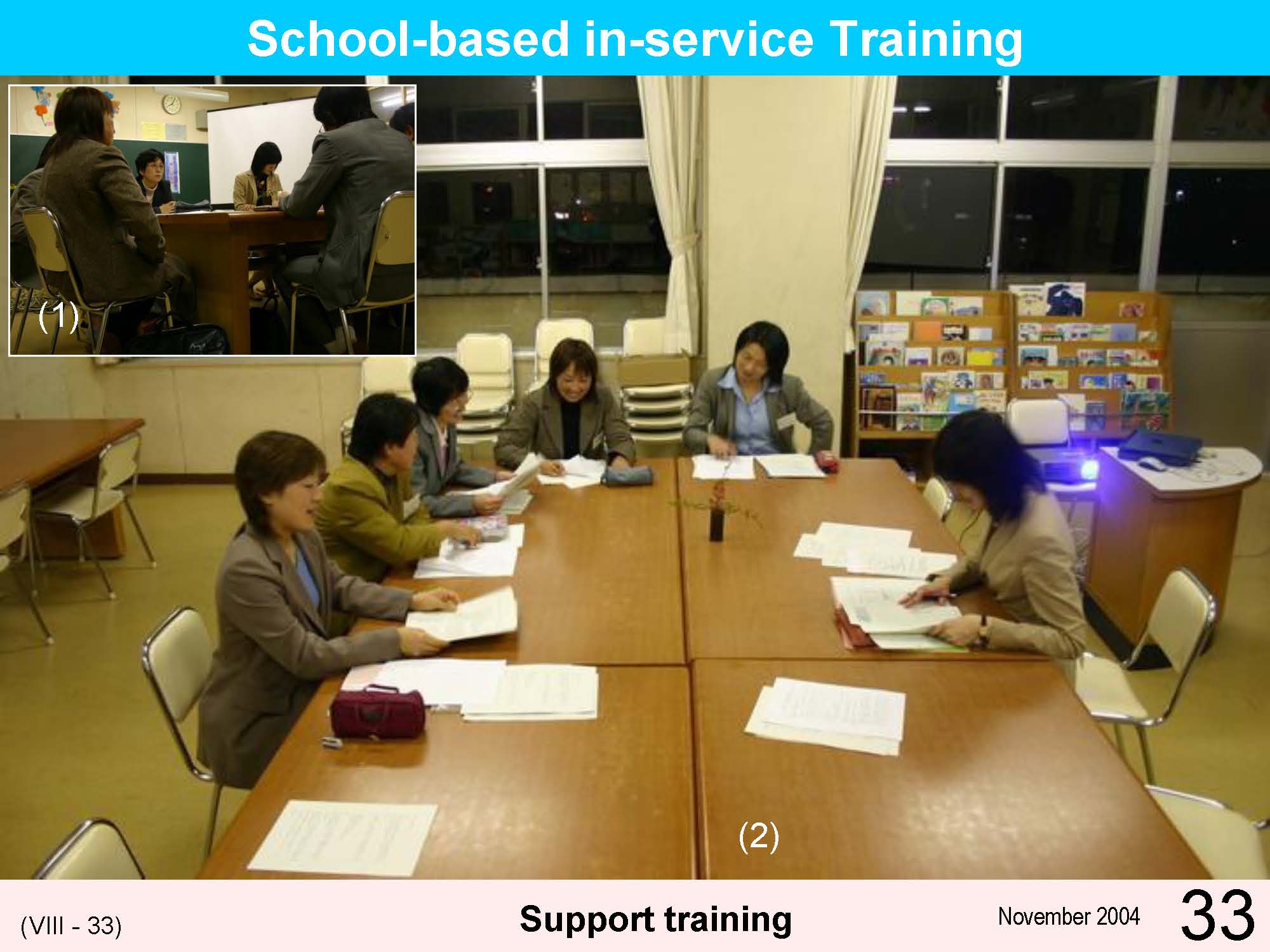 |
Japanese “Reading” (elementary school support training = guidance director comes to school on demand): 4 elementary school teachers, 1 lower secondary school teacher, 1 guidance director (prefectural training center) |
| 34 | 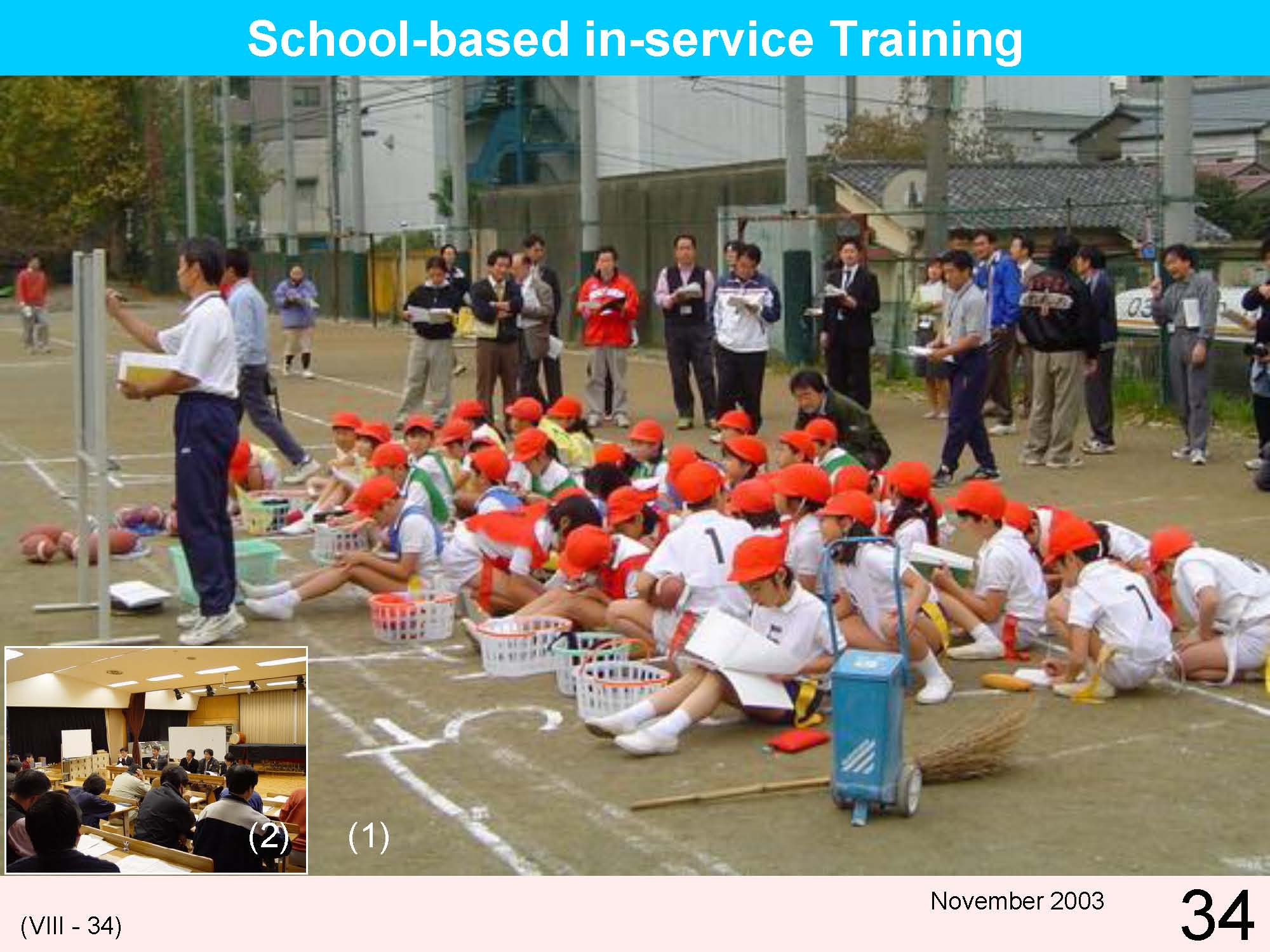 |
Lesson study on P.E., 4th grade |
| 35 | 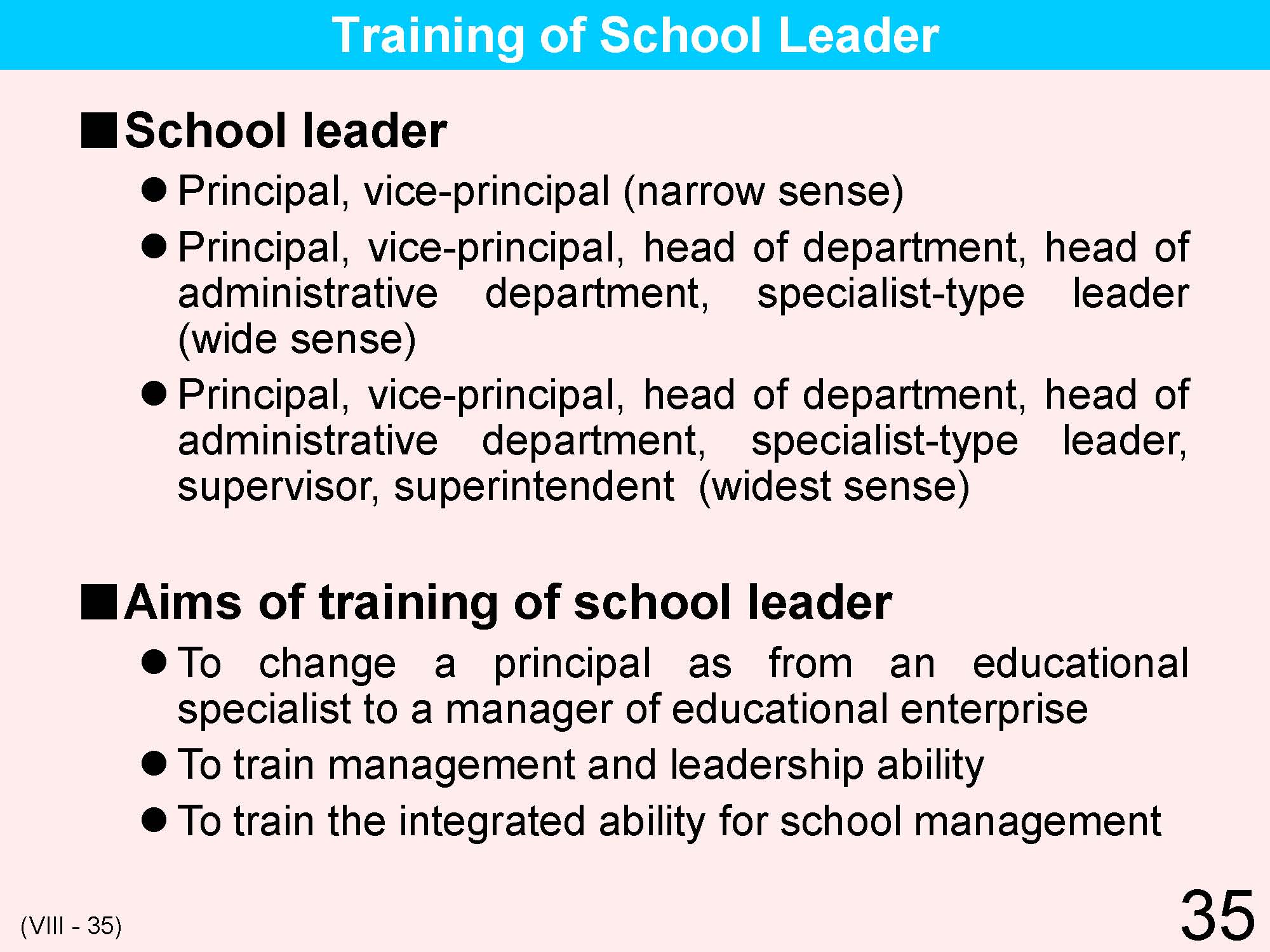 |
The role and leadership of a principal is very important in promoting school independence and autonomy through autonomous school management. Currently in Japan there is a new concept of an ideal type of a principal. A principal is now expected to have the ability to manage and educational business requiring management and leaderships, whereas previously a principal was viewed as an educational specialist. Under legislation providing for a school management council, principals are not only not only expected to understand the legal aspects of the law but also to manage the council. Since this type of ability was not required previously, an adjustment is required by principals to be able to take on and implement such management tasks. This requirement necessitates changes in the training of school leaders that is differs from the past. Normally, school leaders comprise teachers who hold management positions at schools such as principals, vice-principals, various committee heads, and heads of affairs. When viewed in narrow sense, school leaders are limited to principals and vice-principals, while in a wider sense, guidance directors and superintendents of education may be included. The central education committee defines a school leader in general terms, including leading teachers, but does not indicate specific positions such as those of principals and vice-principals. |
| 36 | 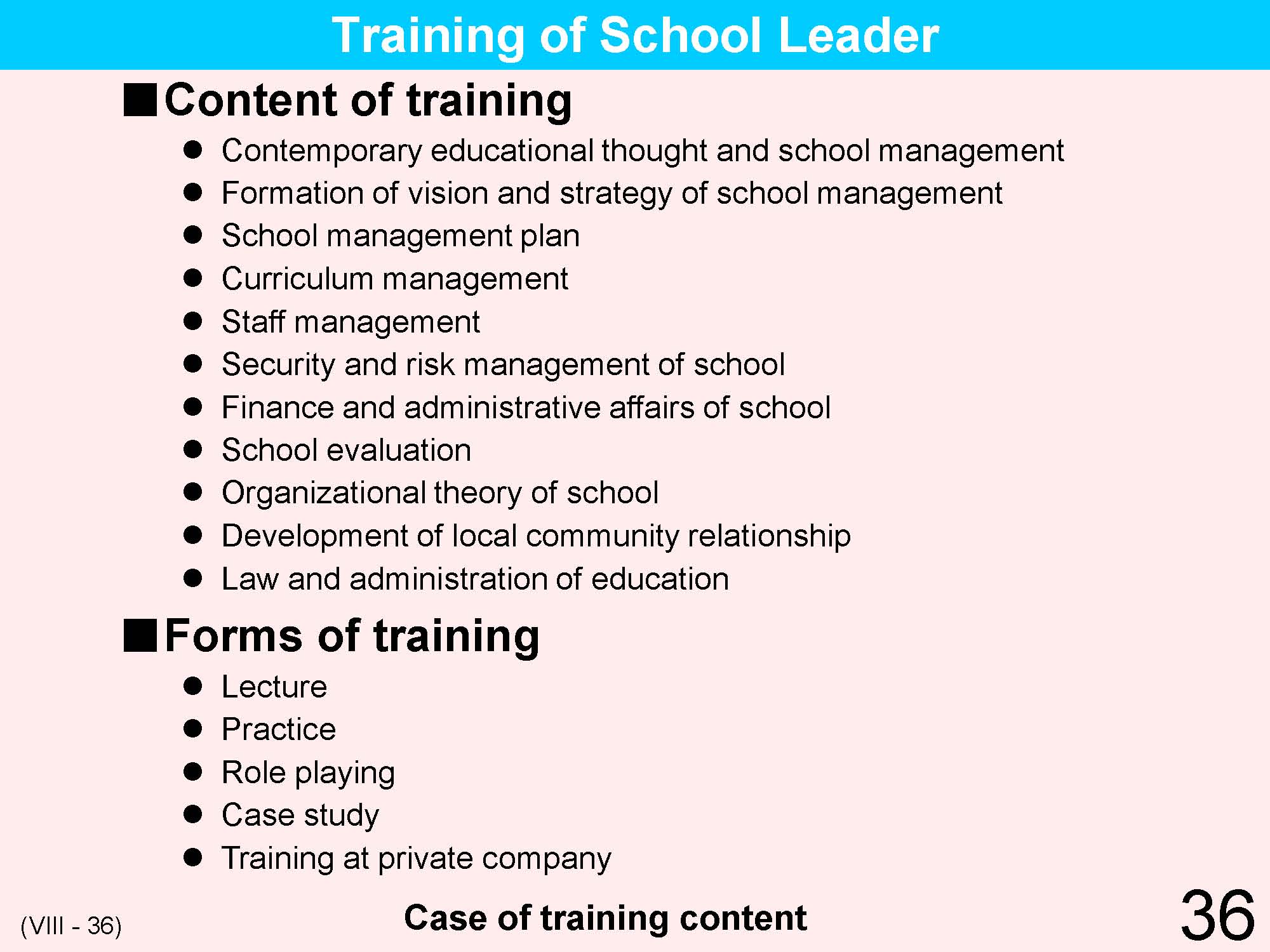 |
The contents of training provided to school leaders are the matters relating to management as shown in the accompanying slide. Under past training of principals, these aspects were not systematically covered. Changes in the roles of principals during the last decade have been accompanied by changes in the contents of training since different abilities are now needed for principals. Since an objective of the training is to nurture the ability to manage and handle problem-solving, case studies represent a very important form of training that provides analysis of management techniques in other school situations that provide lessons for problem solving within one’s own school. Also, training at private companies provides a good opportunity to study management principles that can be applied to schools. |
| 37 | 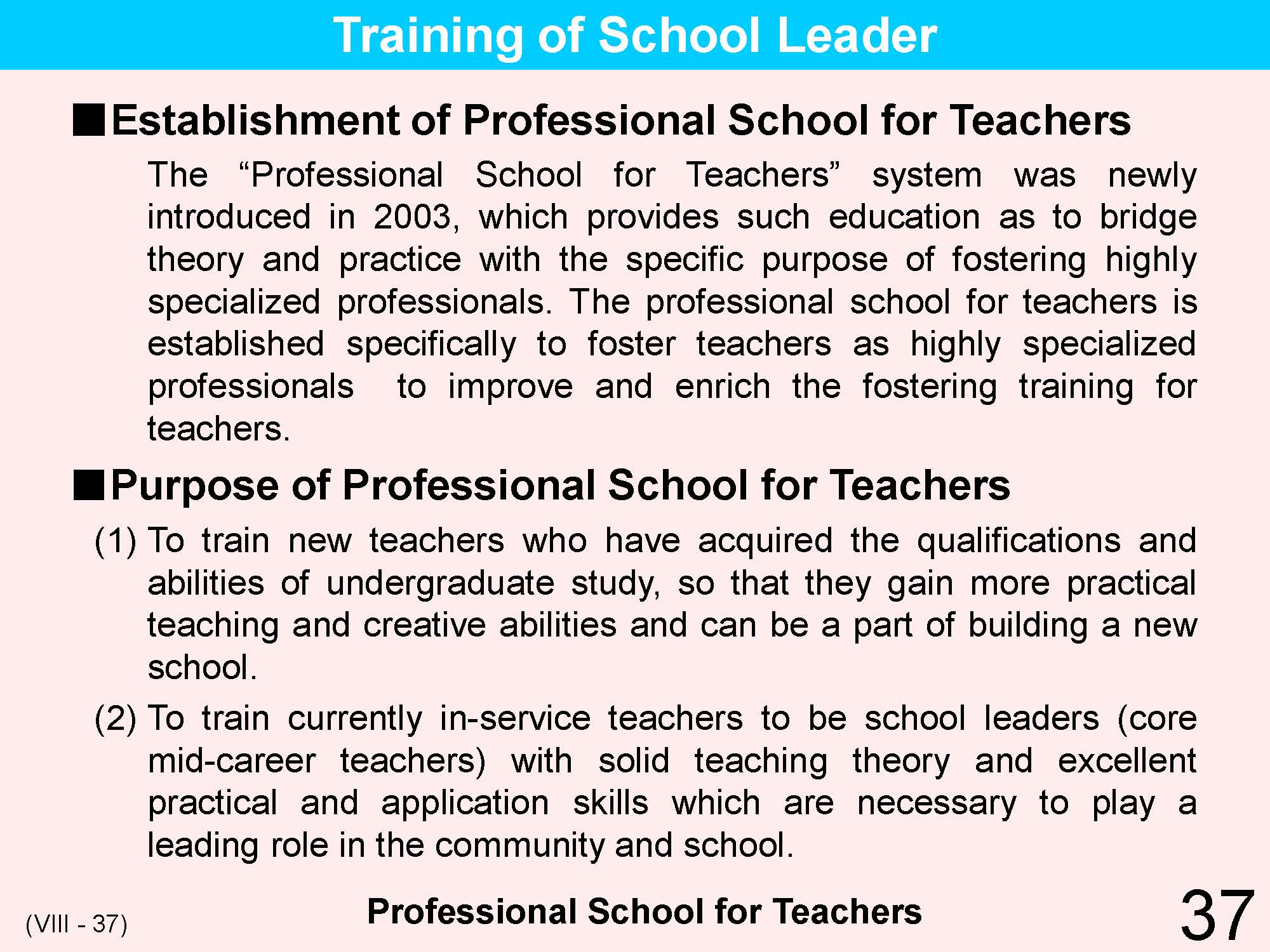 |
Under the framework of Professional graduate school program, the professional school for teachers system was created as the law school system was. It takes 2 years generally and 45 credits to finish, of which more than 10 credits should be earned by teaching practice in school. |
| 38 | 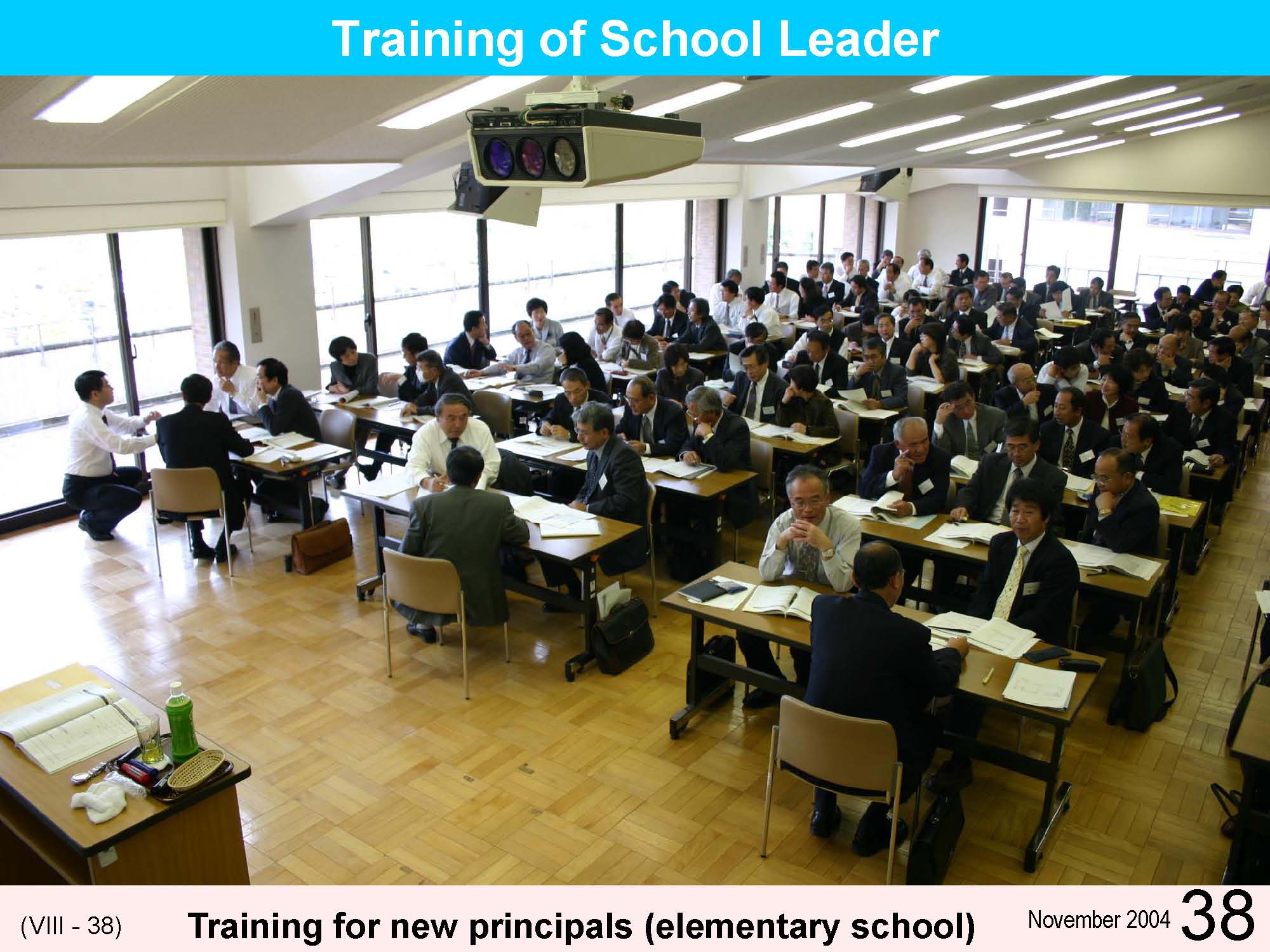 |
Training for new principals of elementary schools (school-leader’s training): organizational management seminer |
| 39 | 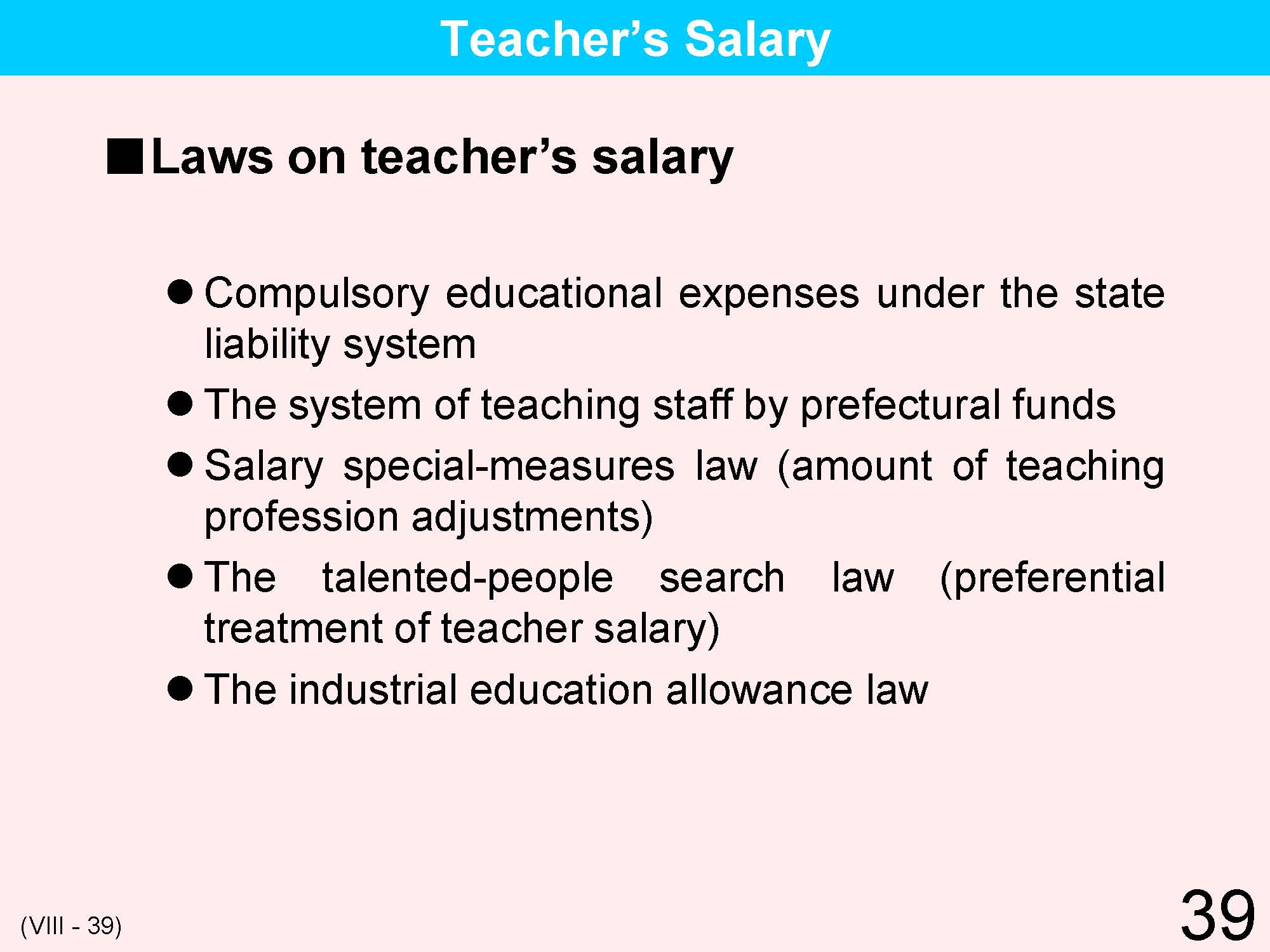 |
Though the municipality board of education establishes public schools of compulsory education level, prefectures pay all the salaries of school personnel to prevent causing differences in school personnel quality among municipalities and to secure stable employment of excellent teachers. In addition, the salaries that municipalities should pay are to be jointly paid by the central government and municipalities. Both of them had been sharing the payment evenly for a long time, but in 2006 the central government began paying one third of the payment. Also, an additional 4% of monthly salaries are paid uniformly, because an overtime payment system is not suitable for teacher’s salary due to the importance of the teaching profession and its special working style. |
| 40 | 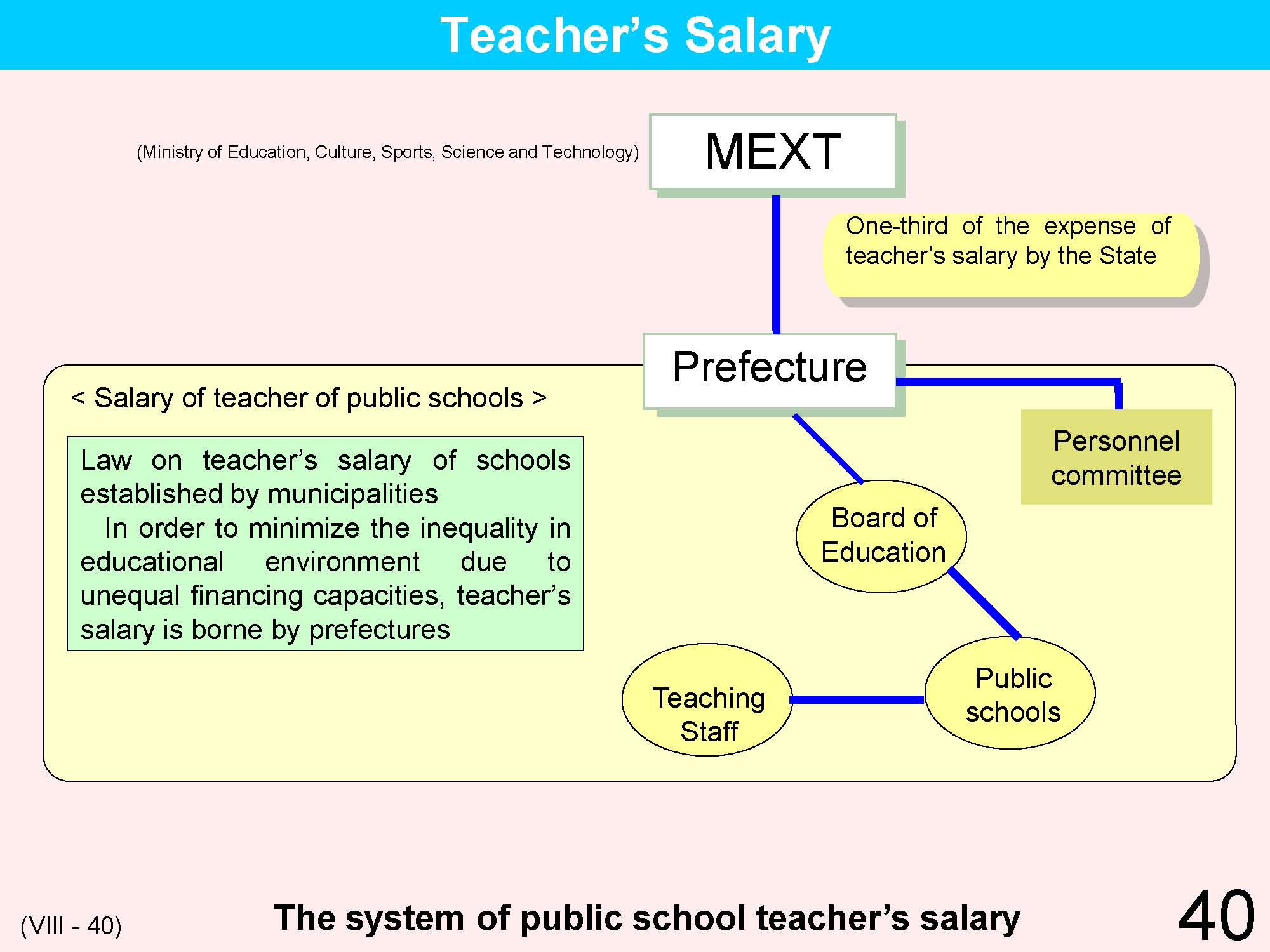 |
Since municipalities establish and manage municipal schools, it is a basic principle that municipalities pay for the salaries of the school staff. However, in order for the financial capabilities of municipalities to be balanced across municipalities in order to prevent the existence of educational gaps from arising between municipalities, and at the same time to ensure that nation-wide academic standards are maintained and improved, it is important that school staff be properly assigned. The financial burden of individual prefectures under this school staff system is determined by such personnel assignments. This system implies that all prefectures pay a salary for school staff within a fixed salary range. Compulsory educational expenses under the State liability system imply that the state pays one-third of teacher salary costs while the the prefectures handle the balance. |
| 41 | 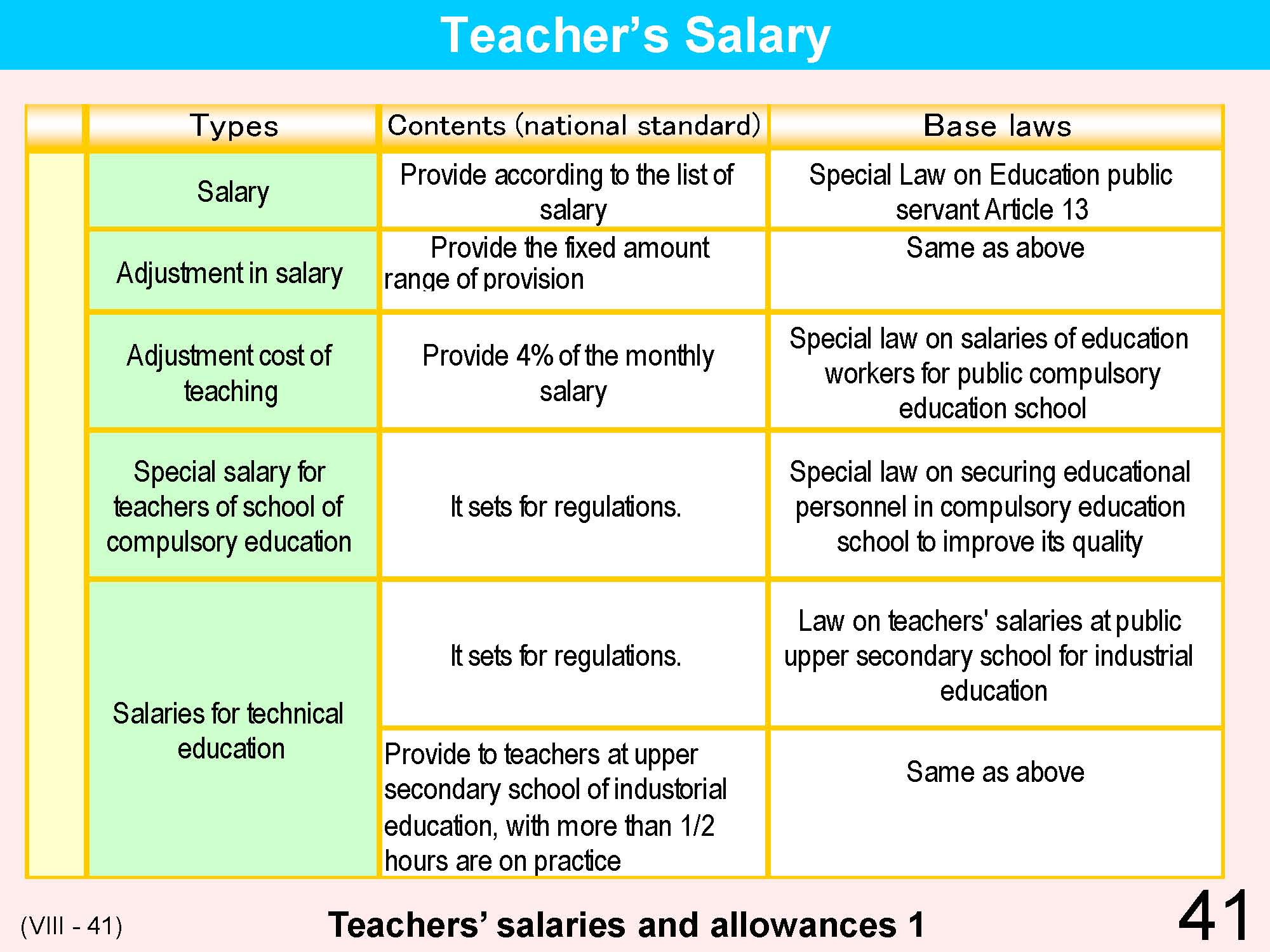 |
Salary is the general term that includes wages, family allowances, adjustment allowances, housing allowances, commuting allowances, industrial education allowances, special allowances, extra work allowances, term end allowances and studying allowances. The state has decided to pay for half of teachers' salaries. (Law on national treasury on expenditure of compulsory education ) This system “aims to ensure the adequate access and quality of education for all Japanese nationals under the principle of free compulsory education, and therefore to provide equal educational opportunities and to improve the quality and standard of education.” (Law on national treasury on expenditure of compulsory education, Article 1) This is the subsidy, and ways to use it are clearly defined. Since the administration of state subsidies would limit the independence of local governments, and since it contradicts the policy of decentralization that is promoted through current administration reforms, there is growing support to abolish the current system and to shift teachers' salaries to be paid from general finances. The report of the central education committee, “Creating compulsory education for the new era” (October, 2005) recommends that the current system be retained, but the policy of the central government currently differs from this recommendation. |
| 42 | 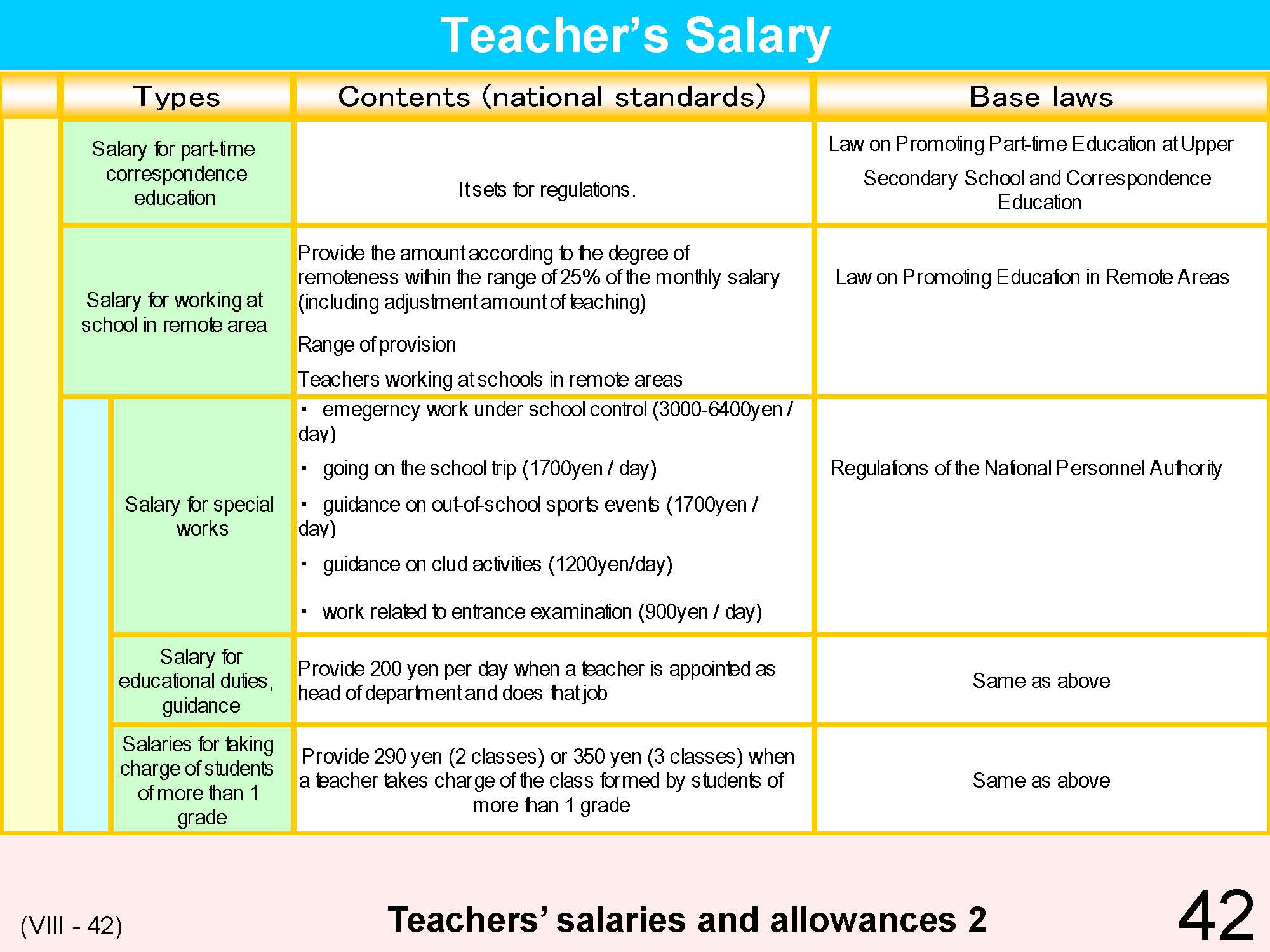 |
Salary is the general term that includes wages, family allowances, adjustment allowances, housing allowances, commuting allowances, industrial education allowances, special allowances, extra work allowances, term end allowances and studying allowances. The state has decided to pay for half of teachers' salaries. (Law on national treasury on expenditure of compulsory education ) This system “aims to ensure the adequate access and quality of education for all Japanese nationals under the principle of free compulsory education, and therefore to provide equal educational opportunities and to improve the quality and standard of education.” (Law on national treasury on expenditure of compulsory education, Article 1) This is the subsidy, and ways to use it are clearly defined. Since the administration of state subsidies would limit the independence of local governments, and since it contradicts the policy of decentralization that is promoted through current administration reforms, there is growing support to abolish the current system and to shift teachers' salaries to be paid from general finances. The report of the central education committee, “Creating compulsory education for the new era” (October, 2005) recommends that the current system be retained, but the policy of the central government currently differs from this recommendation. |
| 43 | 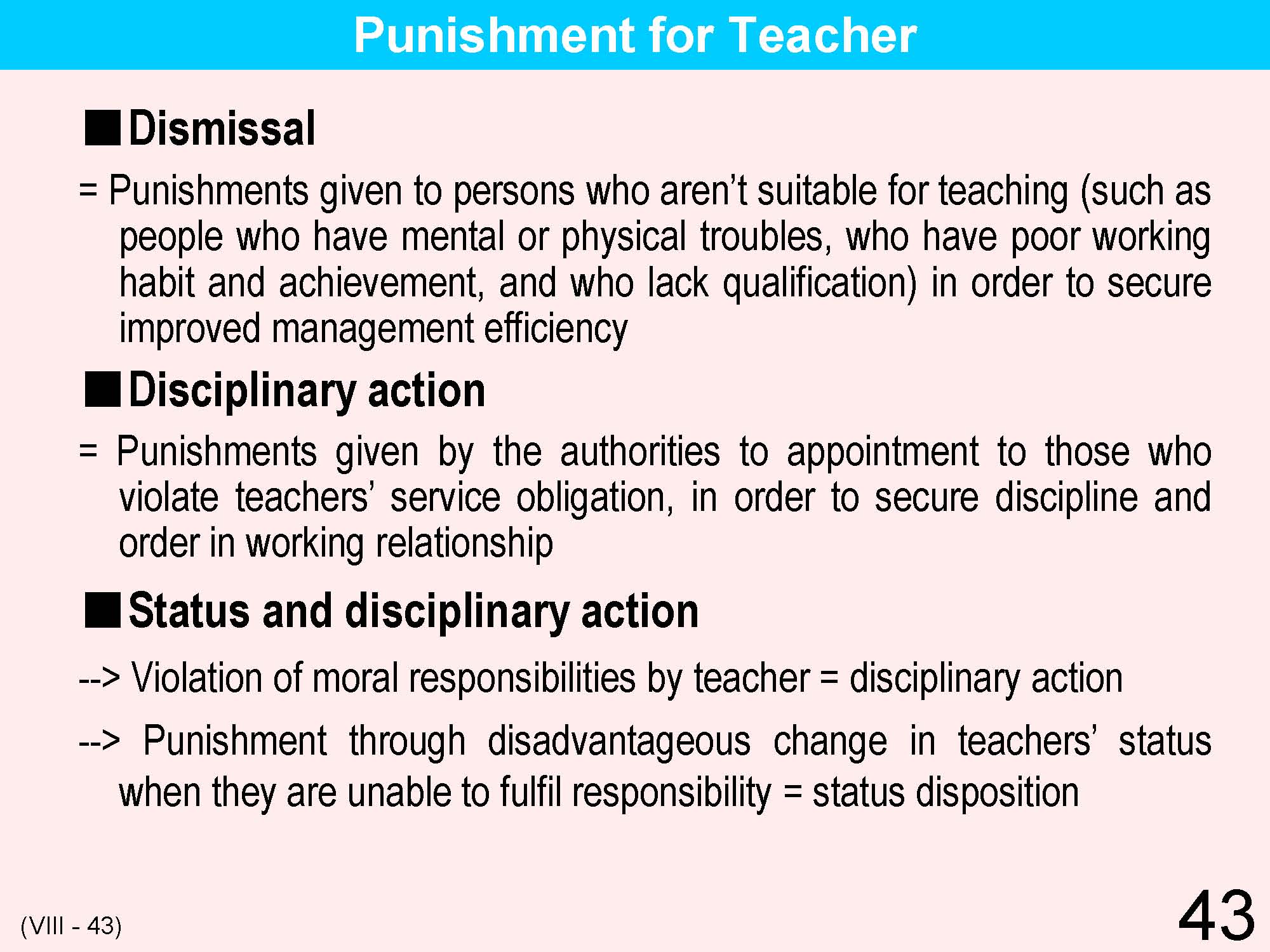 |
The purpose of the threat of dismissal is to help to ensure that teachers perform their official duties efficiently and that school management is conducted appropriately. The purpose of disciplinary action is to maintain official relationships through punishment. The national civil service law (Art. 78, 82) and Local civil service law (Article.28, 29) provide the legal basis for dismissals of and for disciplinary actions against educational personnel. |
| 44 | 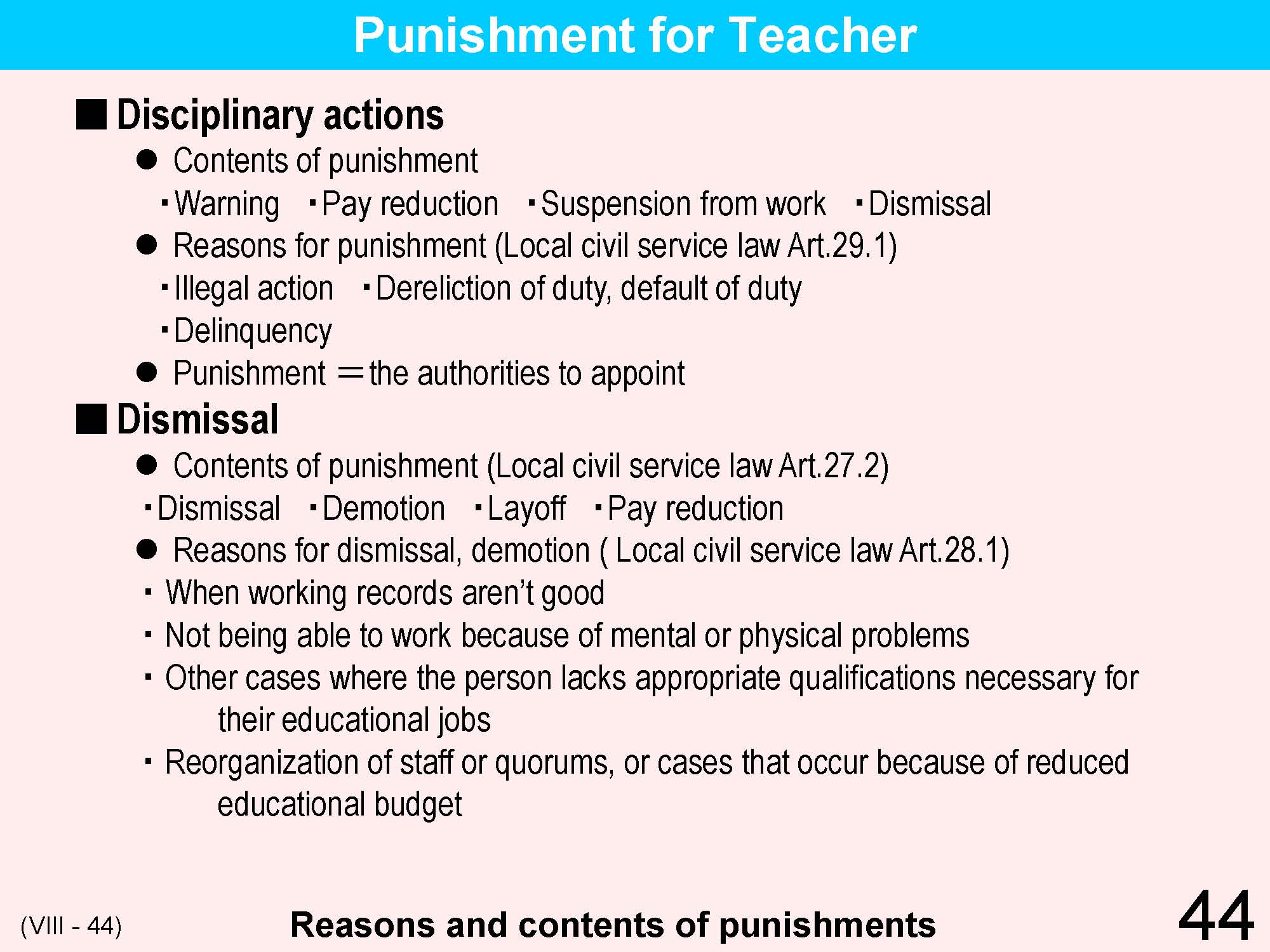 |
Teacher related punishments comprise dismissal, demotion, layoff and pay reductions. Teachers may face dismissal for reasons such as their poor track records, mental and physical problems, and lack of appropriate qualifications. In punishments involving disciplinary actions, there are warnings, pay reductions, suspension from work, and dismissals. Punishments that affect teachers’ positions/status are due to illegal actions, dereliction of duty, default of duty and delinquency. If there are any objections to punishments given, teachers can appeal to personnel committees. |
| 45 | 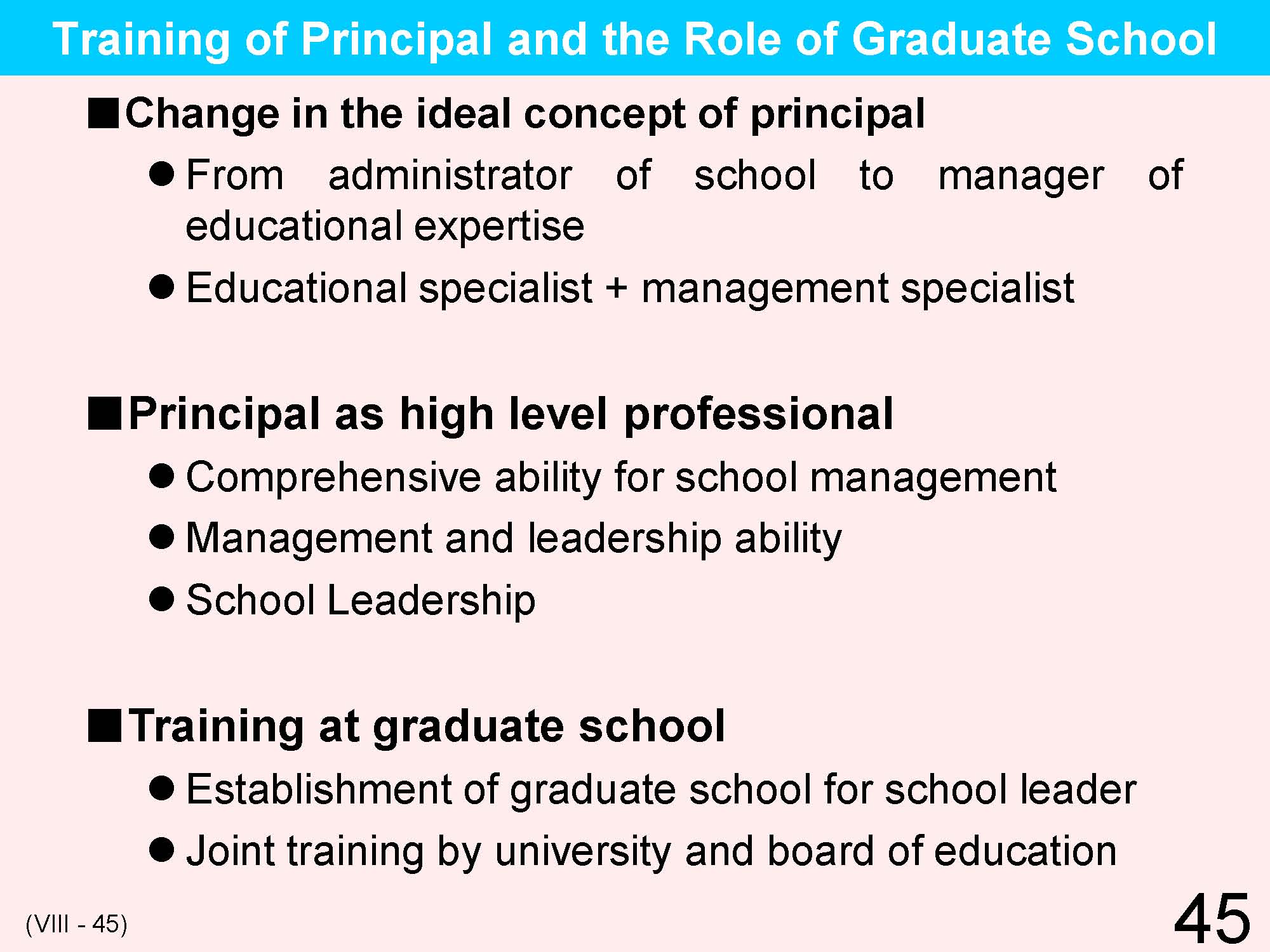 |
The current school management reforms in Japan have changed the concept of an ideal principal, from that of an administrator of a school to a manager of an educational business, or a specialist of management in addition to a specialist of education. In order to manage an educational business effectively, a principal needs to set a vision and a strategy of school development. To do that, it is necessary to have broad views and deep insights not only with reference to education but also to society as a whole. A principal also needs to have professional knowledge and technical skills in implementing school management plans and conducting school evaluations. There are limits provided by experience, on the job training, and administrative training in the development of educational knowledge and technical skills. Consequently, graduate schools play important roles in upgrading the knowledge and skills of principals as do joint training provided by universities and boards of education. There are expanding opportunities to upgrade the skills of principals through the establishment of graduate schools for school leaders. This kind of graduate school has been established at the University of Tsukuba to foster principals. The university of Tsukuba set up a major in “school leadership development” in 2006 to address training for school leader. |
| TOP | ||
Please send your comments and concerns here
kamada@criced.tsukuba.ac.jp
Center for Research on International Cooperation in Educational Development (CRICED) University of Tsukuba
1-1-1, Tennodai, Tsukuba-shi, IBARAKI
305-8572 JAPAN